Light-emitting device and manufacturing method thereof
Hung , et al. A
U.S. patent number 10,388,838 [Application Number 15/787,811] was granted by the patent office on 2019-08-20 for light-emitting device and manufacturing method thereof. This patent grant is currently assigned to GENESIS PHOTONICS INC.. The grantee listed for this patent is Genesis Photonics Inc.. Invention is credited to Cheng-Chuan Chen, Cheng-Wei Hung, Chin-Hua Hung, Yu-Feng Lin.
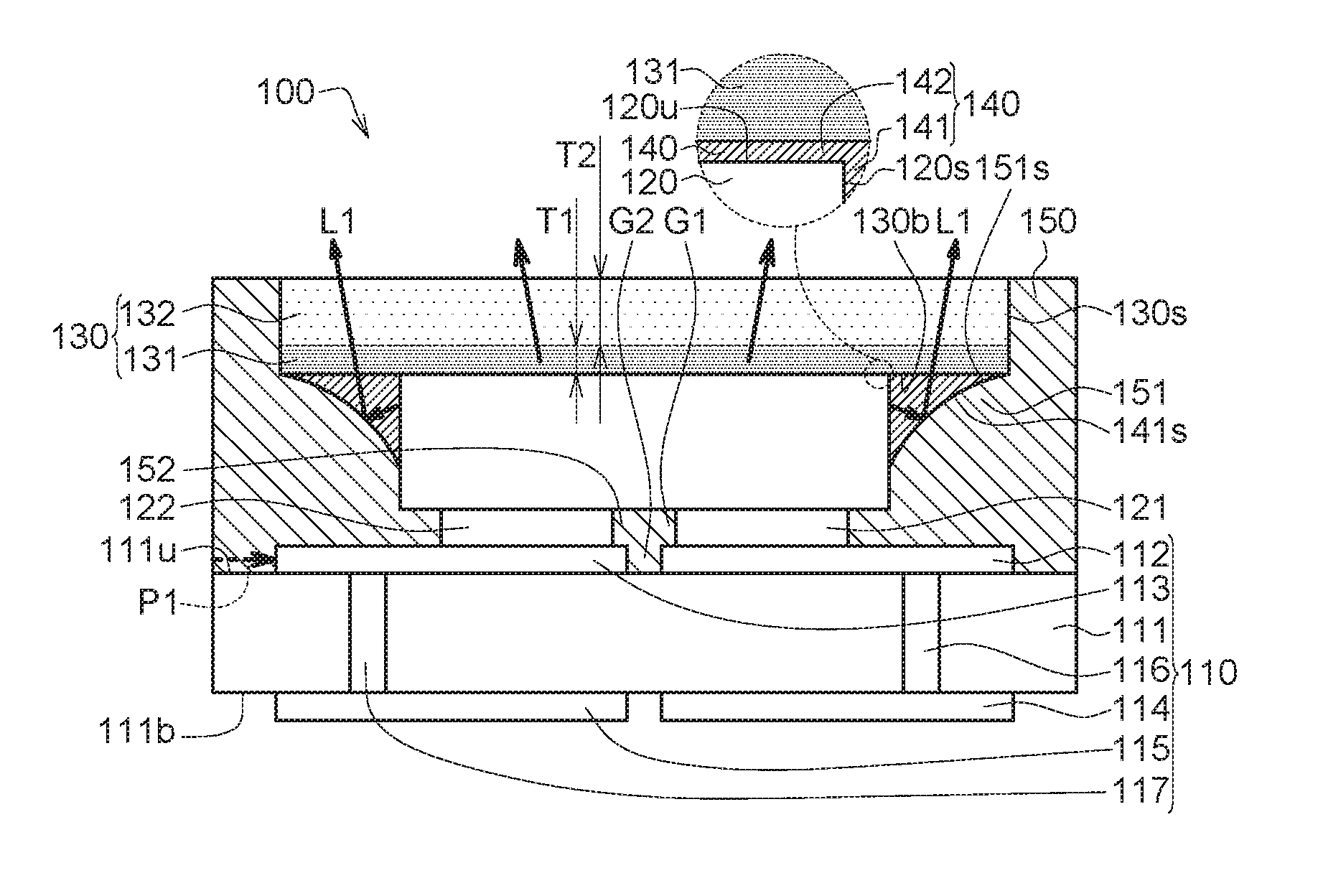
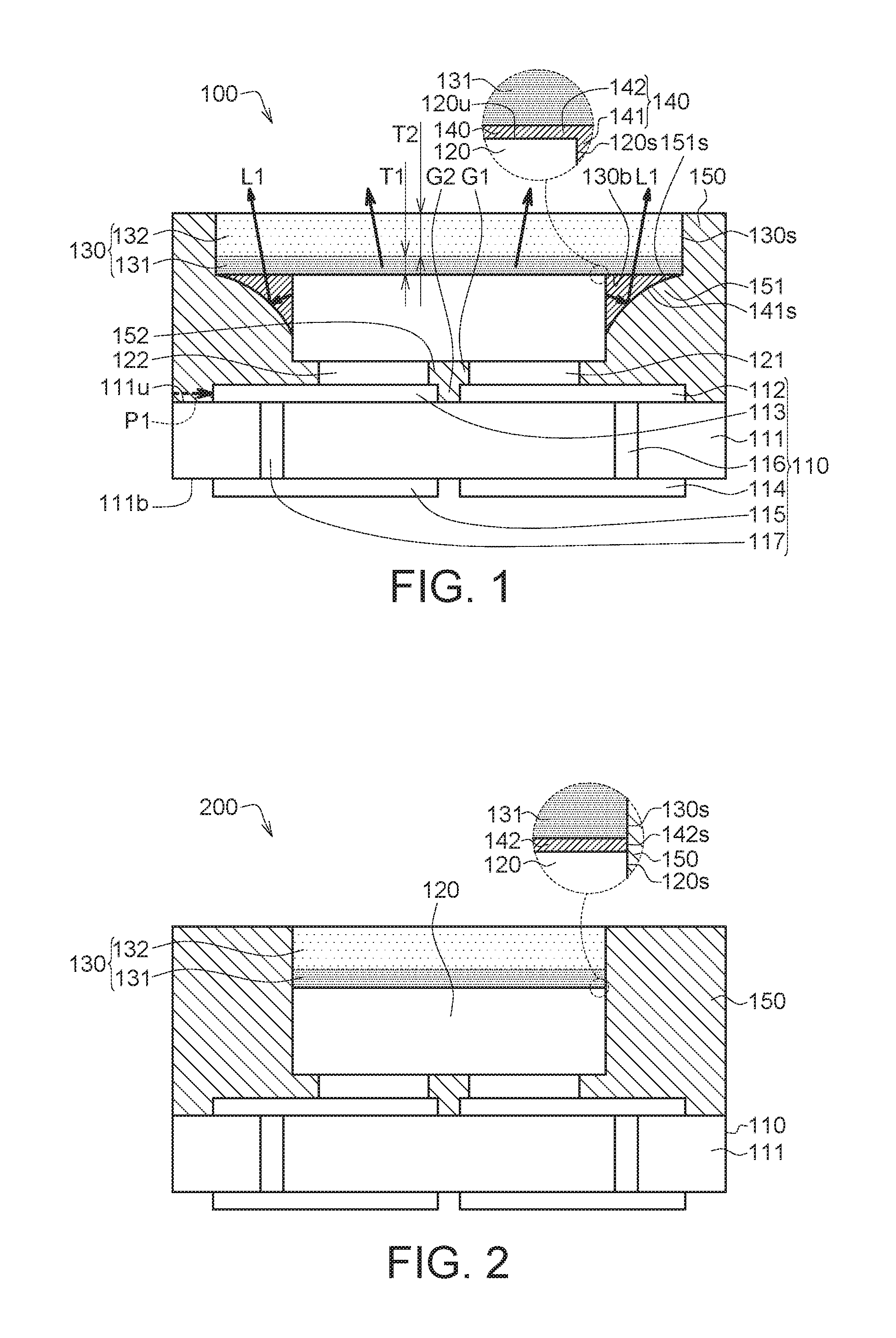
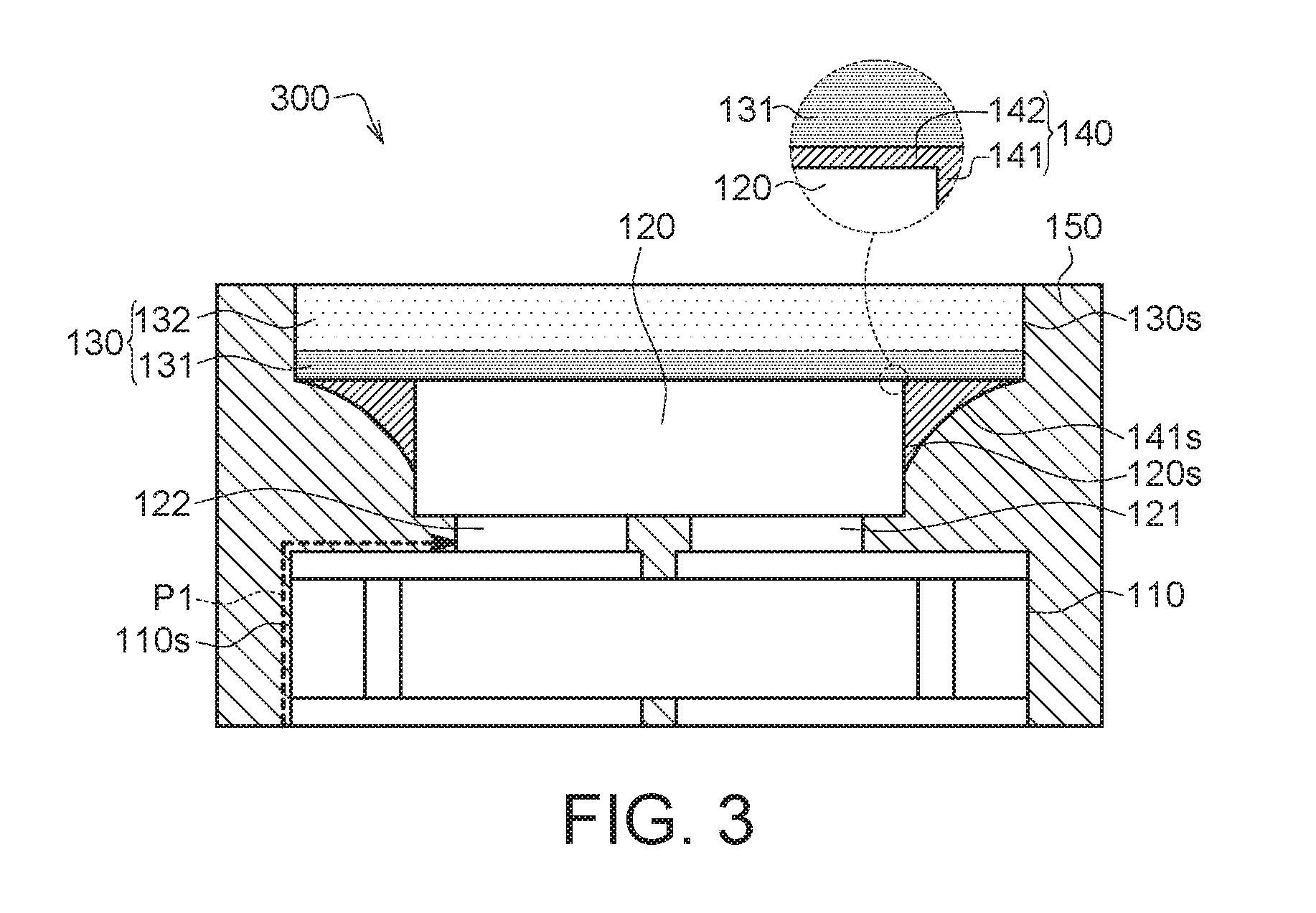




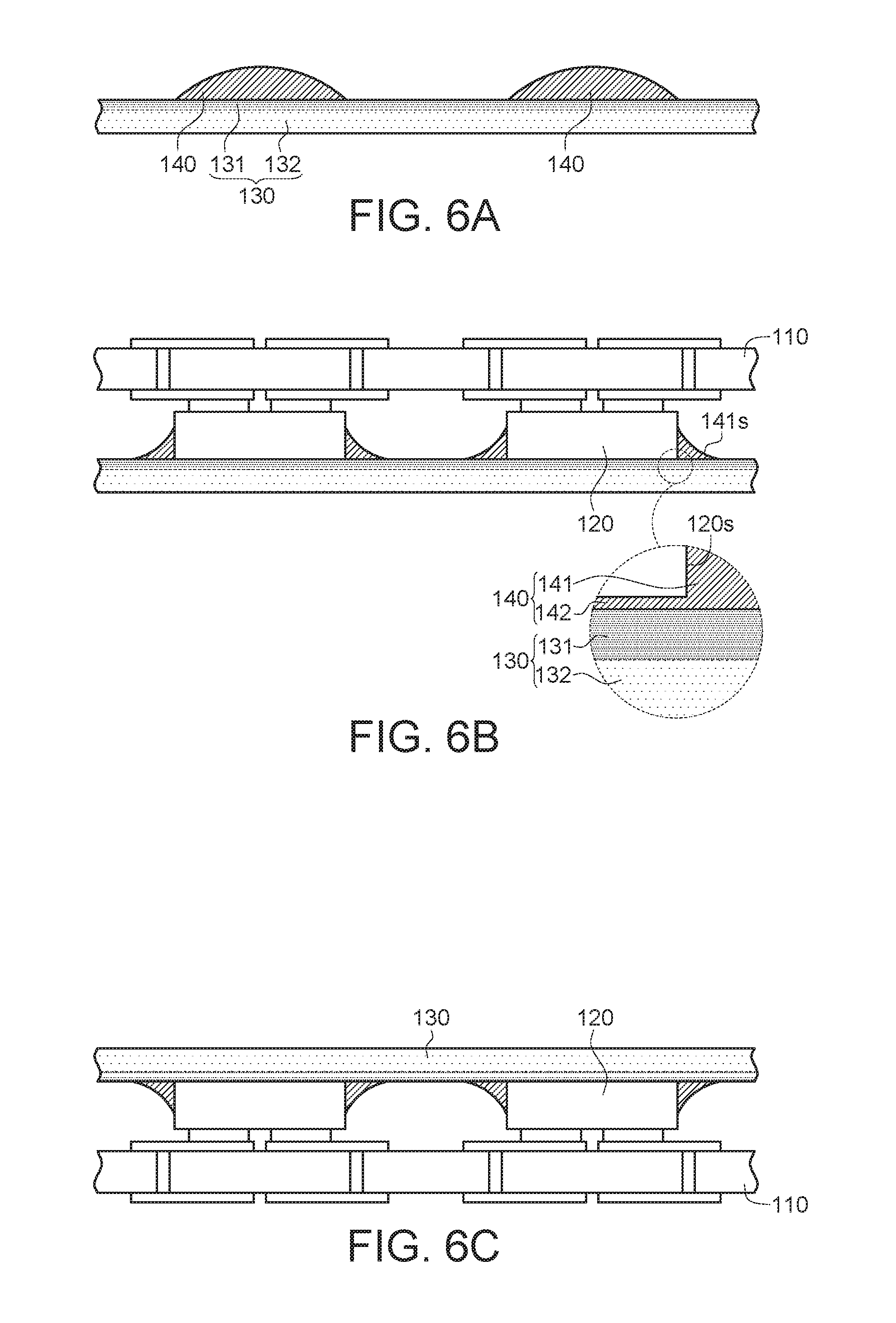
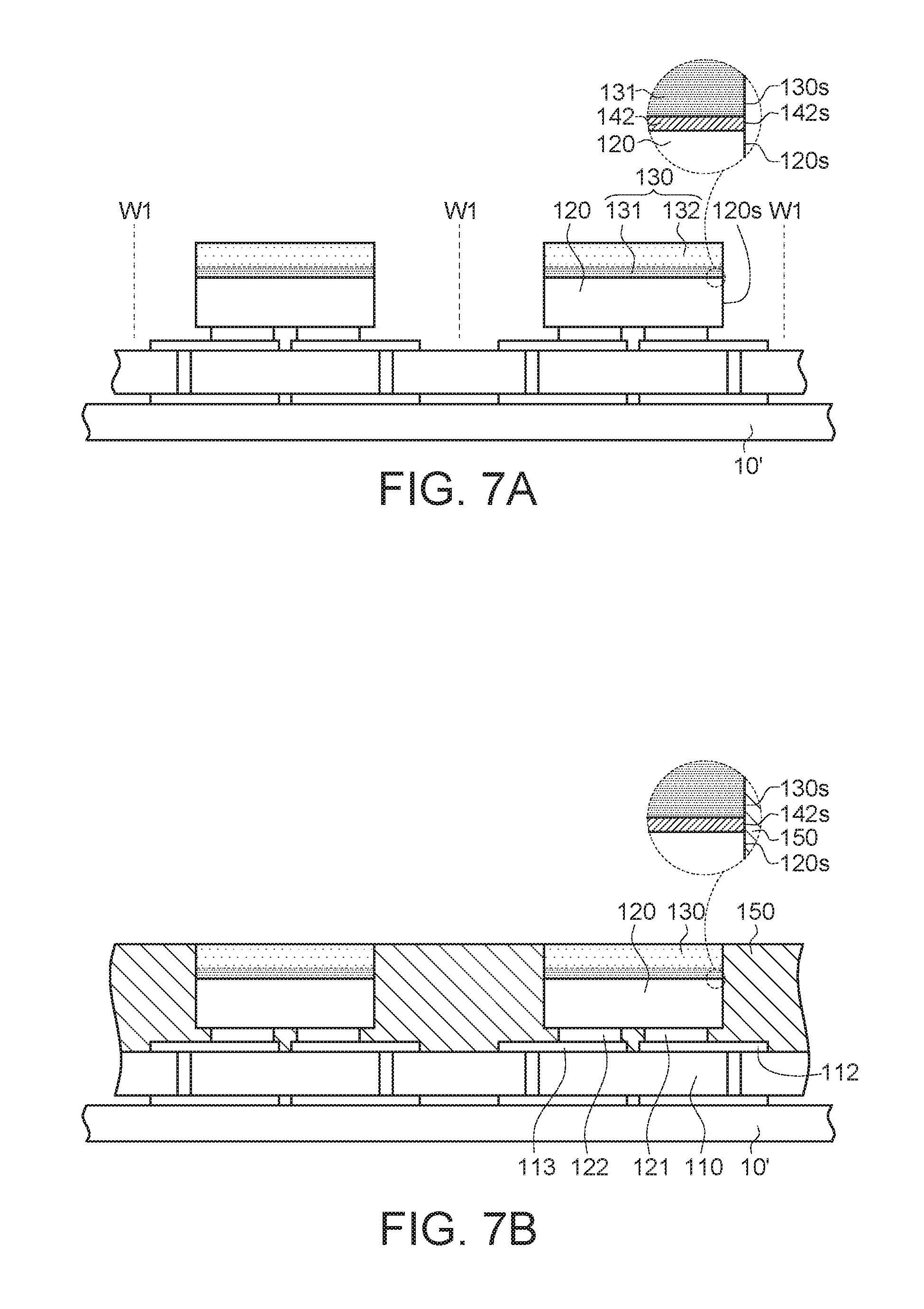
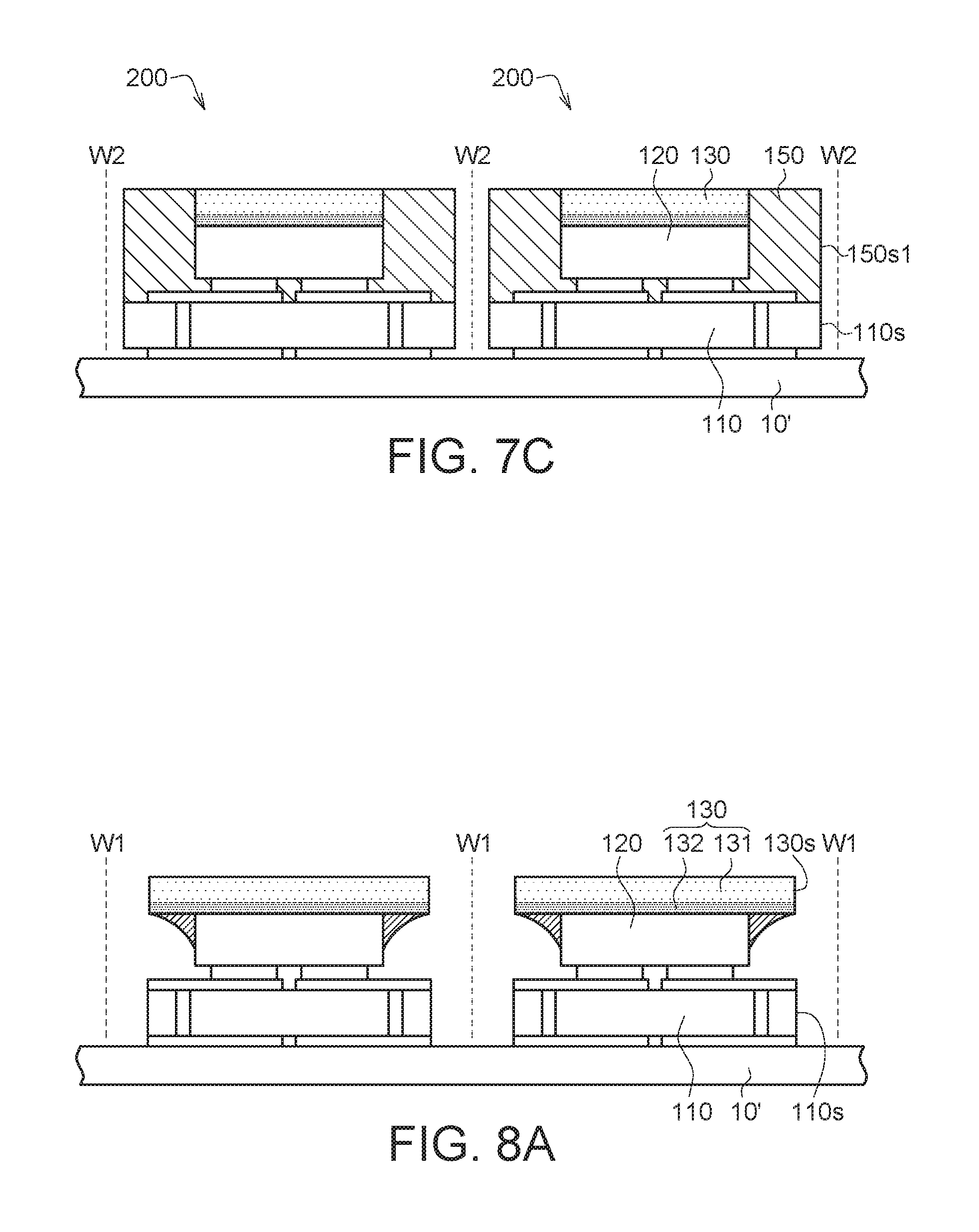
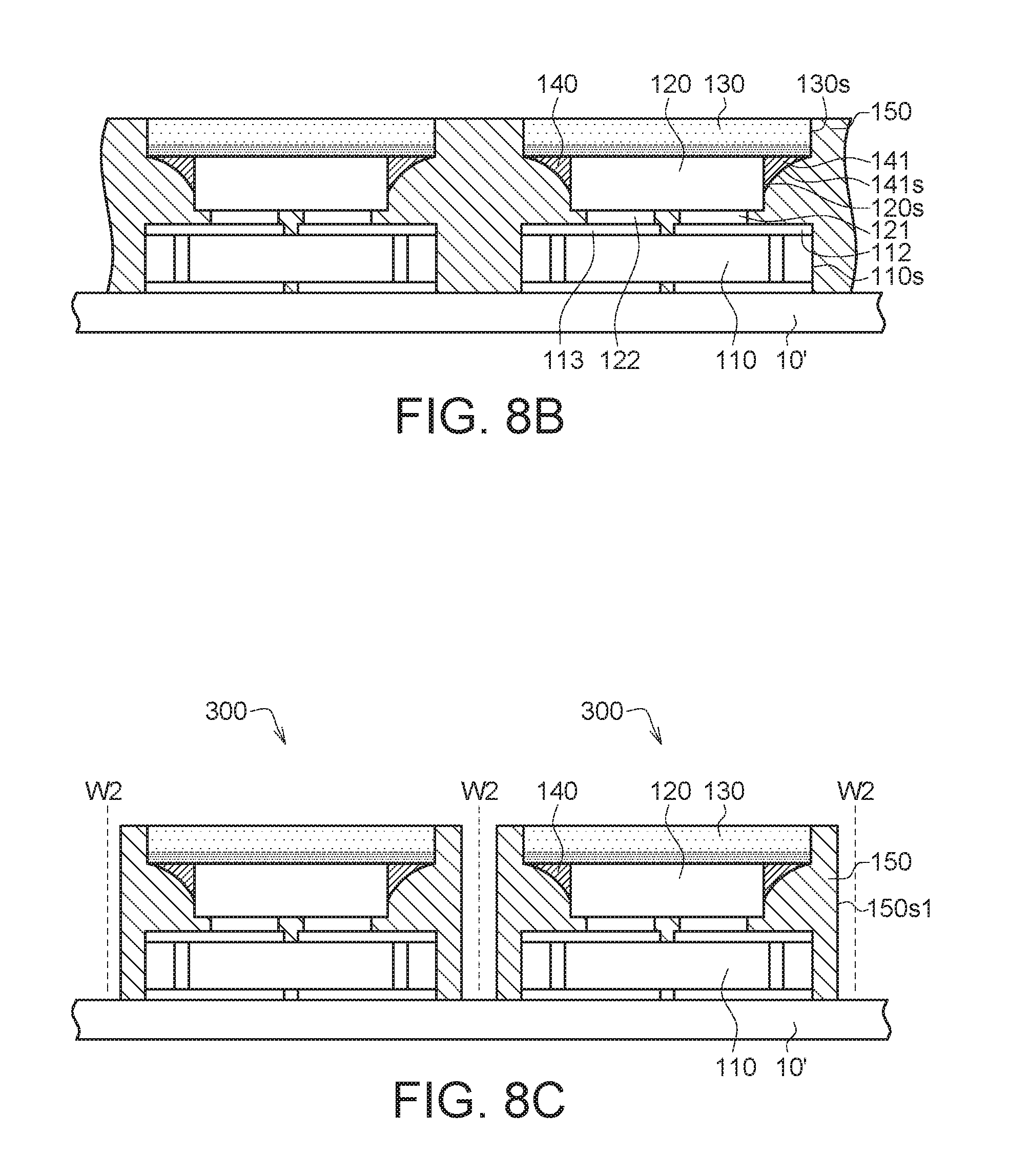

View All Diagrams
| United States Patent | 10,388,838 |
| Hung , et al. | August 20, 2019 |
Light-emitting device and manufacturing method thereof
Abstract
A light-emitting device includes a substrate, a light-emitting component, a translucent layer, an adhesive layer, a reflective layer and translucent encapsulant. The light-emitting component is disposed on the substrate. The adhesive layer is formed between the light-emitting component and the translucent layer. The reflective layer is formed above the substrate and covering a lateral surface of the light-emitting component, a lateral surface of the adhesive layer and a lateral surface of the translucent layer. The translucent encapsulant is formed on the substrate and encapsulating the light-emitting component, the translucent layer and the reflective layer.
| Inventors: | Hung; Chin-Hua (Tainan, TW), Hung; Cheng-Wei (Tainan, TW), Lin; Yu-Feng (Tainan, TW), Chen; Cheng-Chuan (Tainan, TW) | ||||||||||
|---|---|---|---|---|---|---|---|---|---|---|---|
| Applicant: |
|
||||||||||
| Assignee: | GENESIS PHOTONICS INC. (Tainan,
TW) |
||||||||||
| Family ID: | 61997616 | ||||||||||
| Appl. No.: | 15/787,811 | ||||||||||
| Filed: | October 19, 2017 |
Prior Publication Data
| Document Identifier | Publication Date | |
|---|---|---|
| US 20180138378 A1 | May 17, 2018 | |
Related U.S. Patent Documents
| Application Number | Filing Date | Patent Number | Issue Date | ||
|---|---|---|---|---|---|
| 62410376 | Oct 19, 2016 | ||||
| Current U.S. Class: | 1/1 |
| Current CPC Class: | H01L 33/0075 (20130101); H01L 33/26 (20130101); H01L 33/387 (20130101); H01L 33/642 (20130101); H01L 33/56 (20130101); H01L 25/0753 (20130101); H01L 33/507 (20130101); H01L 33/62 (20130101) |
| Current International Class: | H01L 33/56 (20100101); H01L 33/64 (20100101); H01L 33/50 (20100101); H01L 33/00 (20100101); H01L 33/26 (20100101); H01L 33/38 (20100101); H01L 25/075 (20060101); H01L 33/62 (20100101) |
References Cited [Referenced By]
U.S. Patent Documents
| 6155699 | December 2000 | Miller et al. |
| 6919586 | July 2005 | Fujii |
| 7045828 | May 2006 | Shimizu et al. |
| 7190004 | March 2007 | Nagai et al. |
| 7810956 | October 2010 | Bierhuizen et al. |
| 7888691 | February 2011 | Krames |
| 8350283 | January 2013 | Nishiuchi et al. |
| 8362515 | January 2013 | Cheng et al. |
| 8399275 | March 2013 | Akimoto et al. |
| 8461607 | June 2013 | Tsang |
| 8502240 | August 2013 | Kim |
| 8523626 | September 2013 | Suehiro |
| 8552444 | October 2013 | Ide et al. |
| 8552453 | October 2013 | Takine |
| 8723167 | May 2014 | Sato et al. |
| 8771577 | July 2014 | Basin et al. |
| 8860061 | October 2014 | Kotani |
| 8877528 | November 2014 | Ooyabu et al. |
| 8890188 | November 2014 | Park et al. |
| 8957434 | February 2015 | Sugizaki et al. |
| 8987774 | March 2015 | Oyamada |
| 9006763 | April 2015 | Ueno et al. |
| 9022828 | May 2015 | Imai |
| 9065033 | June 2015 | Lee et al. |
| 9337405 | May 2016 | Yamada et al. |
| 9419189 | August 2016 | David et al. |
| 9490398 | November 2016 | Oyamada et al. |
| 9887329 | February 2018 | Yamada |
| 9922963 | March 2018 | Hung |
| 2003/0006509 | January 2003 | Suzuki et al. |
| 2003/0067070 | April 2003 | Kwon et al. |
| 2004/0119402 | June 2004 | Shiang et al. |
| 2005/0045897 | March 2005 | Chou et al. |
| 2006/0055309 | March 2006 | Ono et al. |
| 2006/0169994 | August 2006 | Tu et al. |
| 2006/0186427 | August 2006 | Takine et al. |
| 2007/0012940 | January 2007 | Suh et al. |
| 2007/0114552 | May 2007 | Jang et al. |
| 2007/0236940 | October 2007 | Kuroda et al. |
| 2008/0123024 | May 2008 | Han et al. |
| 2008/0150119 | June 2008 | Jang et al. |
| 2008/0246902 | October 2008 | Cheng |
| 2009/0242917 | October 2009 | Inoue |
| 2009/0296389 | December 2009 | Hsu |
| 2010/0052001 | March 2010 | Li et al. |
| 2010/0066236 | March 2010 | Xu et al. |
| 2010/0117530 | May 2010 | Lin et al. |
| 2010/0258419 | October 2010 | Chung et al. |
| 2010/0258830 | October 2010 | Ide et al. |
| 2011/0001157 | January 2011 | McKenzie et al. |
| 2011/0025190 | February 2011 | Jagt |
| 2011/0079805 | April 2011 | Yu et al. |
| 2011/0102883 | May 2011 | Narendran et al. |
| 2011/0170303 | July 2011 | Wu et al. |
| 2011/0198780 | August 2011 | Basin et al. |
| 2011/0309398 | December 2011 | Ito et al. |
| 2012/0025218 | February 2012 | Ito et al. |
| 2012/0025247 | February 2012 | Ooyabu et al. |
| 2012/0061700 | March 2012 | Eder et al. |
| 2012/0077292 | March 2012 | Chang et al. |
| 2012/0161164 | June 2012 | Kim |
| 2012/0181569 | July 2012 | Choi |
| 2012/0223351 | September 2012 | Margalit |
| 2012/0235126 | September 2012 | Yamazaki et al. |
| 2012/0236582 | September 2012 | Waragaya et al. |
| 2012/0250320 | October 2012 | Harbers et al. |
| 2012/0261700 | October 2012 | Ooyabu et al. |
| 2012/0305942 | December 2012 | Lo et al. |
| 2013/0001605 | January 2013 | Ishihara et al. |
| 2013/0015483 | January 2013 | Shimokawa et al. |
| 2013/0037842 | February 2013 | Yamada et al. |
| 2013/0093313 | April 2013 | Oyamada |
| 2013/0094177 | April 2013 | Edwards |
| 2013/0105978 | May 2013 | Hung |
| 2013/0121000 | May 2013 | Lee et al. |
| 2013/0194794 | August 2013 | Kim |
| 2013/0207141 | August 2013 | Reiherzer |
| 2013/0207142 | August 2013 | Reiherzer |
| 2013/0256711 | October 2013 | Joo et al. |
| 2013/0277093 | October 2013 | Sun et al. |
| 2013/0313594 | November 2013 | Han et al. |
| 2014/0009060 | January 2014 | Kimura et al. |
| 2014/0021493 | January 2014 | Andrews et al. |
| 2014/0054621 | February 2014 | Seko |
| 2014/0117396 | May 2014 | Eisert et al. |
| 2014/0124812 | May 2014 | Kuramoto et al. |
| 2014/0131753 | May 2014 | Ishida |
| 2014/0138725 | May 2014 | Oyamada |
| 2014/0153238 | June 2014 | Nishimura et al. |
| 2014/0186979 | July 2014 | Tu et al. |
| 2014/0203451 | July 2014 | Kwon et al. |
| 2014/0252389 | September 2014 | Koizumi et al. |
| 2015/0014720 | January 2015 | Tien |
| 2015/0102373 | April 2015 | Lee et al. |
| 2015/0102377 | April 2015 | Huang et al. |
| 2015/0115300 | April 2015 | Tomizawa et al. |
| 2015/0179901 | June 2015 | Ok et al. |
| 2015/0188004 | July 2015 | Ozeki |
| 2015/0200338 | July 2015 | Kim et al. |
| 2015/0263242 | September 2015 | Tomizawa et al. |
| 2015/0280078 | October 2015 | Yen et al. |
| 2015/0311405 | October 2015 | Oyamada et al. |
| 2016/0013373 | January 2016 | Bhat et al. |
| 2016/0035952 | February 2016 | Yamada et al. |
| 2016/0079496 | March 2016 | Huang et al. |
| 2016/0155900 | June 2016 | Bono et al. |
| 2016/0155915 | June 2016 | Ling et al. |
| 2016/0181476 | June 2016 | Chang et al. |
| 2016/0190406 | June 2016 | Liu et al. |
| 1366715 | Aug 2002 | CN | |||
| 1971957 | May 2007 | CN | |||
| 1624944 | Apr 2010 | CN | |||
| 101855735 | Oct 2010 | CN | |||
| 101867003 | Oct 2010 | CN | |||
| 101878540 | Nov 2010 | CN | |||
| 101978516 | Feb 2011 | CN | |||
| 102074639 | May 2011 | CN | |||
| 102130071 | Jul 2011 | CN | |||
| 102132428 | Jul 2011 | CN | |||
| 102214623 | Oct 2011 | CN | |||
| 102222757 | Oct 2011 | CN | |||
| 102347423 | Feb 2012 | CN | |||
| 102468417 | May 2012 | CN | |||
| 102738368 | Oct 2012 | CN | |||
| 102804426 | Nov 2012 | CN | |||
| 103022010 | Apr 2013 | CN | |||
| 103050601 | Apr 2013 | CN | |||
| 103137571 | Jun 2013 | CN | |||
| 103403890 | Nov 2013 | CN | |||
| 103531725 | Jan 2014 | CN | |||
| 103534822 | Jan 2014 | CN | |||
| 103682038 | Mar 2014 | CN | |||
| 203774363 | Aug 2014 | CN | |||
| 204155931 | Feb 2015 | CN | |||
| 2011114093 | Jun 2011 | JP | |||
| 2012227470 | Nov 2012 | JP | |||
| 200841089 | Oct 2008 | TW | |||
| 200929615 | Jul 2009 | TW | |||
| 201017934 | May 2010 | TW | |||
| 201114072 | Apr 2011 | TW | |||
| 201133956 | Oct 2011 | TW | |||
| 201210819 | Mar 2012 | TW | |||
| 201218428 | May 2012 | TW | |||
| 201220534 | May 2012 | TW | |||
| 201220560 | May 2012 | TW | |||
| 201242108 | Oct 2012 | TW | |||
| 201249898 | Dec 2012 | TW | |||
| 201308691 | Feb 2013 | TW | |||
| 201319460 | May 2013 | TW | |||
| 201507209 | Feb 2015 | TW | |||
| 201515282 | Apr 2015 | TW | |||
| 2011093454 | Jun 2013 | WO | |||
Other References
|
TIPO Office Action dated Jan. 9, 2018 in Taiwan application (No. 106135995). cited by applicant . TIPO Office Action dated Jan. 16, 2018 in Taiwan application (No. 106131096). cited by applicant . CN Office Action dated Nov. 14, 2017 in Chinese application (No. 201410362787.6). cited by applicant . Office Action issued by USPTO dated Aug. 20, 2015 (U.S. Appl. No. 14/462,581). cited by applicant . Office Action issued by USPTO dated Oct. 7, 2015 (U.S. Appl. No. 14/542,657). cited by applicant . Office Action issued by USPTO dated May 6, 2016 (U.S. Appl. No. 14/542,657). cited by applicant . Office Action issued by USPTO dated Oct. 25, 2016 (U.S. Appl. No. 15/045,471). cited by applicant . Office Action issued by USPTO dated Nov. 4, 2016 (U.S. Appl. No. 15/168,218). cited by applicant . Office Action issued by TIPO dated Nov. 17, 2016 (No. TW104144809). cited by applicant . Office Action issued by USPTO dated Dec. 16, 2016 (U.S. Appl. No. 14/711,798). cited by applicant . Office Action issued by TIPO on Dec. 22, 2016 (No. TW105126842). cited by applicant . Office Action issued by USPTO dated Jan. 25, 2017 (U.S. Appl. No. 14/542,657). cited by applicant . Office Action issued by USPTO dated Feb. 7, 2017 (U.S. Appl. No. 15/268,681). cited by applicant . Office Action issued by USPTO dated Mar. 10, 2017 (U.S. Appl. No. 15/073,672). cited by applicant . Office Action issued by USPTO dated Mar. 31, 2017 (U.S. Appl. No. 15/073,673). cited by applicant . Office Action issued by USPTO dated May 1, 2017(U.S. Appl. No. 15/073,707). cited by applicant . Office Action issued by SIPO dated May 22, 2017 (No. CN 201410362787.6). cited by applicant . Office Action issued by USPTO dated May 24, 2017 (U.S. Appl. No. 15/073,715). cited by applicant . Office Action issued by USPTO dated Jun. 15, 2017 (U.S. Appl. No. 15/268,654). cited by applicant . Notice of Allowance issued by USPTO dated Jul. 20, 2017 (U.S. Appl. No. 15/168,218). cited by applicant . Office Action issued by USPTO dated Jul. 28, 2017 (U.S. Appl. No. 14/711,798). cited by applicant . Office Action issued by TIPO dated Aug. 10, 2017 (No. TW106108220). cited by applicant . Office Action issued by USPTO dated Sep. 29, 2017 (U.S. Appl. No. 14/542,657). cited by applicant . Non-Final Office Action issued in U.S. Appl. No. 15/908,779, filed Feb. 28, 2018, dated Apr. 4, 2018. cited by applicant . Final Office Action issued in U.S. Appl. No. 15/073,673, filed Mar. 18, 2016, dated Feb. 8, 2018. cited by applicant . CN Office Action dated Aug. 20, 2018 in Chinese application (No. 201410362787.6). cited by applicant . CN Office Action dated Apr. 27, 2018 in Chinese application (No. 201510244596.4). cited by applicant . Non-Final Office Action issued in U.S. Appl. No. 15/959,534, filed Apr. 23, 2018, dated Jun. 21, 2018. cited by applicant . Non-Final Office Action issued in U.S. Appl. No. 15/657,299, filed Jul. 24, 2017, dated May 16, 2018. cited by applicant . CN Office Action dated Nov. 28, 2018 in Chinese application (No. 201610156784.6). cited by applicant . CN Office Action dated Jan. 22, 2019 in Chinese application (No. 201610293182.5). cited by applicant . TIPO Office Action dated Dec. 6, 2018 in Taiwan application (No. 107119063). cited by applicant . Chinese language office action dated Nov. 2, 2018, issued in application No. CN 201610156914.6. cited by applicant . Chinese language office action dated Nov. 1, 2018, issued in application No. CN 201610157140.9. cited by applicant . Office action dated Nov. 29, 2018, issued in U.S. Appl. No. 15/973,552. cited by applicant . Non-Final Office Action issued in U.S. Appl. No. 15/881,802, filed Jan. 29, 2018, dated Aug. 10, 2018. cited by applicant . Final Office Action issued in U.S. Appl. No. 15/657,299, filed Jul. 24, 2017, dated Oct. 2, 2018. cited by applicant . Non-Final Office Action issued in U.S. Appl. No. 16/004,445, filed Jun. 11, 2018, dated Sep. 27, 2018. cited by applicant . TIPO Office Action dated Oct. 5, 2018 in Taiwan application (No. 104131083). cited by applicant . TIPO Office Action dated Sep. 20, 2018 in Taiwan application (No. 104125226). cited by applicant . Non-Final Office Action issued in U.S. Appl. No. 15/823,480, filed Nov. 27, 2017, dated Dec. 31, 2018. cited by applicant . TW Office Action dated Jun. 11, 2019 in Taiwan application (No. 107117295). cited by applicant . CN Office Action dated Dec. 3, 2018 in Chinese application (No. 201610157182.2). cited by applicant . CN Office Action dated Dec. 4, 2018 in Chinese application (No. 201610089097.7). cited by applicant. |
Primary Examiner: Assouman; Herve-Louis Y
Attorney, Agent or Firm: McClure, Qualey & Rodack, LLP
Parent Case Text
This application claims the benefits of U.S. provisional application Ser. No. 62/410,376, filed Oct. 19, 2016, the subject matters of which are incorporated herein by reference.
Claims
What is claimed is:
1. A light-emitting device, comprises: a substrate; a light-emitting component coupled to the substrate; a wavelength conversion layer comprising a high-density phosphor layer and a low-density phosphor layer; an adhesive layer adhering the wavelength conversion layer directly to an upper surface of the light-emitting component and covering a portion of a lateral surface of the light-emitting component, wherein the high-density phosphor layer faces to the upper surface of the light-emitting component; a reflective layer formed above the substrate and covering the light-emitting component, the adhesive layer and the wavelength conversion layer to expose an upper surface of the wavelength conversion layer, wherein a curved surface of the reflective layer is inclined to the lateral surface of the light-emitting component and reflects a light emitted from the light-emitting component back into the high-density phosphor layer; and a dome-shaped lens layer formed on the substrate and encapsulating the light-emitting component, the wavelength conversion layer, the adhesive layer and the reflective layer.
2. The light-emitting device according to claim 1, wherein the dome-shaped lens layer encapsulates a lateral surface of an electrode of the light-emitting component.
3. The light-emitting device according to claim 1, wherein the dome-shaped lens layer is spaced from the substrate.
4. The light-emitting device according to claim 1, wherein the light-emitting device has a flat lateral surface comprising the dome-shaped lens layer and the substrate.
5. The light-emitting device according to claim 3, wherein the reflective layer has a lower portion disposed between the dome-shaped lens and the substrate.
6. The light-emitting device according to claim 1, wherein the reflective layer is spaced from the substrate.
7. The light-emitting device according to claim 5, wherein the light-emitting device has a flat lateral surface comprising the dome-shaped lens layer, the reflective layer and the substrate.
8. The light-emitting device according to claim 6, wherein the light-emitting component has a body and electrodes disposed on a bottom surface thereof, and a bottom surface of the reflective layer is not lower than the bottom surface of the body of the light-emitting component.
9. The light-emitting device according to claim 1, wherein the dome-shaped lens layer comprises resin containing phosphor particles.
10. The light-emitting device according to claim 1, wherein a thickness of the low-density phosphor layer is larger than a thickness of the high-density phosphor layer.
11. The light-emitting device according to claim 1, wherein an upper surface of the reflective layer and the upper surface of the wavelength conversion layer are coplanar.
Description
TECHNICAL FIELD
The disclosure relates in general to a light-emitting device and a manufacturing method thereof, and more particularly to a light-emitting device having a reflective layer and a manufacturing method thereof.
BACKGROUND
Conventional light-emitting device includes a phosphor glue and a light-emitting component, wherein the phosphor glue covers an upper surface and a lateral surface of the light-emitting component. The high temperature generated by the light-emitting component, when illuminating, will negatively affect the phosphor glue, speed up the deterioration of the phosphor glue and change the light color.
Therefore, it has become a prominent task for the industry to slow the deterioration of the phosphor glue.
SUMMARY
Thus, the disclosure provides a light-emitting device capable of relieving the deterioration of the phosphor glue and a manufacturing method thereof.
According to one embodiment, a light-emitting device is provided. The light-emitting device includes a substrate, a light-emitting component, a translucent layer, an adhesive layer, a reflective layer and translucent encapsulant. The light-emitting component is disposed on the substrate. The adhesive layer is formed between the light-emitting component and the translucent layer. The reflective layer is formed above the substrate and covering a lateral surface of the light-emitting component, a lateral surface of the adhesive layer and a lateral surface of the translucent layer. The translucent encapsulant is formed on the substrate and encapsulating the light-emitting component, the translucent layer and the reflective layer.
According to another embodiment, a manufacturing method of a light-emitting device is provided. The manufacturing method includes the following steps. A substrate and a light-emitting component disposed on the substrate are provided; a translucent layer is provided; the translucent layer is connected with the light-emitting component by an adhesive layer; a reflective layer is formed above the substrate, wherein the reflective layer covers a lateral surface of the light-emitting component, a lateral surface of the adhesive layer and a lateral surface of the translucent layer; and a translucent encapsulant is formed on the substrate to encapsulate the light-emitting component, the translucent layer and the reflective layer.
The above and other aspects of the invention will become better understood with regard to the following detailed description of the preferred but non-limiting embodiment(s). The following description is made with reference to the accompanying drawings.
BRIEF DESCRIPTION OF THE DRAWINGS
FIG. 1 illustrates a cross-sectional view of a light-emitting device according to an embodiment of the invention;
FIG. 2 illustrates a cross sectional view of a light-emitting device according to another embodiment of the invention;
FIG. 3 illustrates a cross sectional view of a light-emitting device according to another embodiment of the invention;
FIG. 4 illustrates a cross sectional view of a light-emitting device according to another embodiment of the invention;
FIGS. 5A to 5H illustrate manufacturing processes of the light-emitting device of FIG. 1;
FIGS. 6A to 6C illustrate another manufacturing processes of the light-emitting device of FIG. 1;
FIGS. 7A to 7C illustrate manufacturing processes of the light-emitting device of FIG. 2;
FIGS. 8A to 8C illustrate manufacturing processes of the light-emitting device of FIG. 3;
FIGS. 9A to 9F illustrate manufacturing processes of the light-emitting device of FIG. 4;
FIG. 10 illustrates a cross sectional view of a light-emitting device according to another embodiment of the invention;
FIG. 11 illustrates a cross sectional view of a light-emitting device according to another embodiment of the invention;
FIG. 12 illustrates a cross sectional view of a light-emitting device according to another embodiment of the invention;
FIG. 13 illustrates a cross sectional view of a light-emitting device according to another embodiment of the invention;
FIG. 14 illustrates a cross sectional view of a light-emitting device according to another embodiment of the invention;
FIG. 15 illustrates a cross sectional view of a light-emitting device according to another embodiment of the invention;
FIG. 16 illustrates a cross sectional view of a light-emitting device according to another embodiment of the invention;
FIGS. 17A to 17G illustrate manufacturing processes of the light-emitting device of FIG. 10;
FIG. 18 illustrates manufacturing process of the light-emitting device of FIG. 11;
FIGS. 19A to 19F illustrate manufacturing processes of the light-emitting device of FIG. 12;
FIGS. 20A to 20C illustrate manufacturing processes of the light-emitting device of FIG. 13;
FIGS. 21A to 21C illustrate manufacturing processes of the light-emitting device of FIG. 14;
FIG. 22 illustrates manufacturing process of the light-emitting device of FIG. 15; and
FIG. 23 illustrates manufacturing process of the light-emitting device of FIG. 16.
DETAILED DESCRIPTION
FIG. 1 illustrates a cross-sectional view of a light-emitting device 100 according to an embodiment of the invention. The light-emitting device 100 includes a substrate 110, a light-emitting component 120, a wavelength conversion layer 130, an adhesive layer 140 and a reflective layer 150.
The substrate 110 is, for example, a ceramic substrate. In the present embodiment, the substrate 110 includes a base 111, a third electrode 112, a fourth electrode 113, a first pad 114, a second pad 115, a first conductive post 116 and a second conductive post 117.
The base 111 is made of a material such as silicon-based material. The base 111 has a first surface 111u and a second surface 111b opposite to the first surface 111u. The third electrode 112 and the fourth electrode 113 are formed on the first surface 111u of the base 111, and the first pad 114 and the second pad 115 are formed on the second surface 111b of the base 111. The first conductive post 116 and the second conductive post 117 pass through the base 111, wherein the first conductive post 116 connects the third electrode 112 to the first pad 114 for electrically connecting the third electrode 112 to the first pad 114, and the second conductive post 117 connects the fourth electrode 113 to the second pad 115 for electrically connecting the fourth electrode 113 to the second pad 115.
The light-emitting device 100 may be disposed on a circuit board (not illustrated), wherein the first pad 114 and the second pad 115 of the substrate 110 are electrically connected to two electrodes (not illustrated) of the circuit board, such that the light-emitting component 120 is electrically connected to the circuit board through the first pad 114 and the second pad 115.
The light-emitting component 120 is disposed on the substrate 110. The light-emitting component 120 includes a first electrode 121 and a second electrode 122, wherein the first electrode 121 and the second electrode 122 are electrically connected to the third electrode 112 and the fourth electrode 113 respectively.
The light-emitting component 120 is, for example, a light-emitting diode. Although not illustrated, the light-emitting component 120 may further comprise a first type semiconductor layer, a second type semiconductor layer and a light emitting layer, wherein the light emitting layer is formed between the first type semiconductor layer and the second type semiconductor layer. The first type semiconductor layer is realized by such as an N-type semiconductor layer, and the second type semiconductor layer is realized by such as a P-type semiconductor layer. Alternatively, the first type semiconductor layer is realized by such as a P-type semiconductor layer, and the second type semiconductor layer is realized by such as an N-type semiconductor layer. The P-type semiconductor is realized by a GaN-based semiconductor doped with trivalent elements such as a gallium nitride based semiconductor layer which is doped with Beryllium (Be), zinc (Zn), manganese (Mn), chromium (Cr), magnesium (Mg), calcium (Ca), etc. The N-type semiconductor is realized by a GaN-based semiconductor doped with doped with silicon (Si), germanium (Ge), tin (Sn), sulfur (S), oxygen (O), titanium (Ti) and or zirconium (Zr), etc. The light emitting layer may be realized, but is not limited to, by a structure of InxAlyGal-x-yN (0.ltoreq.x0.ltoreq.yx+y.ltoreq.1) or a structure which is doped with Boron (B), phosphorus (P) or arsenic (As). In addition, the light emitting layer may be a single-layered structure or multi-layered structure.
The first electrode 121 may be realized by a single-layered structure or a multi-layered structure which is made of at least one of materials including gold, aluminum, silver, copper, rhodium (Rh), ruthenium (Ru), palladium (Pd), iridium (Ir), platinum (Pt), chromium, tin, nickel, titanium, tungsten (W), chromium alloys, titanium tungsten alloys, nickel alloys, copper silicon alloy, aluminum silicon copper alloy, aluminum silicon alloy, gold tin alloy, but is not limited thereto. The second electrode 122 may be realized by a single-layered structure or a multi-layered structure. The second electrode 122 may be made of a material similar to that of the first electrode 121.
The wavelength conversion layer 130 includes a high-density phosphor layer 131 and a low-density phosphor layer 132. The wavelength conversion layer 130 includes a plurality of phosphor particles, wherein a region whose phosphor particle density is higher is defined as the high-density phosphor layer 131, and a region whose phosphor particle density is lower is defined as the low-density phosphor layer 132. In an embodiment, a ratio of a phosphor particle density of the high-density phosphor layer 131 and a phosphor particle density of the low-density phosphor layer 132 ranges between 1 and 10.sup.15, wherein the range may contain or may not contain 1 and 10.sup.15.
In the present embodiment, the high-density phosphor layer 131 is located between the light-emitting component 120 and the low-density phosphor layer 132. That is, the light emitted from the light-emitting component 120 first passes through the high-density phosphor layer 131, and then is emitted out of the wavelength conversion layer 130 through the low-density phosphor layer 132. Due the design of the high-density phosphor layer 131, the light color of the light-emitting device 100 can be collectively distributed in the chromaticity coordinate. As a result, the yield of the light-emitting device 100 may be increased. The low-density phosphor layer 132 may increase a light mixing probability. In detail, for the light L1 which has not contacted the phosphor particles within the high-density phosphor layer 131 yet, the low-density phosphor layer 132 increases the probability of the light L1 contacting the phosphor particles. In the present embodiment, a thickness T2 of the low-density phosphor layer 132 is larger than a thickness T1 of the high-density phosphor layer 131, and accordingly the light mixing probability of the light L1 of the light-emitting component 120 can be further increased. In an embodiment, a ratio of the thickness T2 and the thickness T1 ranges between 1 and 1000, wherein the range may contain or may not contain 1 and 1000.
The wavelength conversion layer 130 covers the entire upper surface 120u of the light-emitting component 120. That is, in the present embodiment, the area of the wavelength conversion layer 130 viewed from the top view is larger than the area of the light-emitting component 120 viewed from the top view. In an embodiment, a ratio of the area of the wavelength conversion layer 130 viewed from the top view and the area of the light-emitting component 120 viewed from the top view ranges between 1 and 1.35, however less than 1 or larger than 1.35 is also feasible.
In an embodiment, the wavelength conversion layer 130 may be made of a material including sulfide, Yttrium aluminum garnet (YAG), LuAG, silicate, nitride, oxynitride, fluoride, TAG, KSF, KTF, etc.
The adhesive layer 140 includes, but is not limited to, transparent resin, wherein the transparent resin includes, but is not limited to, silicone, epoxy resin or other synthetic resin. The adhesive layer 140 includes a first lateral portion 141 and a heat resistance layer 142. The first lateral portion 141 covers a portion of a lateral surface 120s of the light-emitting component 120, and another portion or the other portion of the lateral surface 120s of the light-emitting component 120 is covered by the reflective layer 150. Viewed from the direction of the top view of FIG. 1, the first lateral portion 141 is shaped into a closed ring shape which surrounds the entire lateral surface 120s of the light-emitting component 120. In another embodiment, the first lateral portion 141 may be shaped into an open ring shape.
As illustrated in an enlargement view of FIG. 1, the heat resistance layer 142 of the adhesive layer 140 is formed between the high-density phosphor layer 131 and the light-emitting component 120, and accordingly it can increase the heat resistance between the light-emitting component 120 and the wavelength conversion layer 130 to slows the degrading speed of the wavelength conversion layer 130. In detail, if the heat generated from the light-emitting component 120 is easily transmitted to the wavelength conversion layer 130, it will speed up the deterioration of the phosphor particles within the wavelength conversion layer 130. In the present embodiment, due to the forming of the heat resistance layer 142, the heat transmitted to the wavelength conversion layer 130 can be decreased, and accordingly it can slow the deterioration of the phosphor particles within the wavelength conversion layer 130. In an embodiment, the thickness of the heat resistance layer 142 may range between 1 and 1000, wherein the range may contain or may not contain 1 and 1000.
The reflective layer 150 is formed above the substrate 110 and covers the lateral surface 120s of the light-emitting component 120, a lateral surface 141s of the first lateral portion 141 of the adhesive layer 140 and a lateral surface 130s of the wavelength conversion layer 130, and accordingly it can advantageously protect the light-emitting component 120 and the wavelength conversion layer 130 from being exposed to be damaged. The reflective layer 150 may reflect the light L1 emitted from the lateral surface 120s of the light-emitting component 120 to the wavelength conversion layer 130, and accordingly it can increase the luminous efficiency of the light-emitting device 100.
As illustrated in FIG. 1, the reflective layer 150 further covers a lateral surface of the first electrode 121, a lateral surface of the second electrode 122, a lateral surface of the third electrode 112 and a lateral surface of the fourth electrode 113. As a result, it can prevent the first electrode 121, the second electrode 122, the third electrode 112 and the fourth electrode 113 from being exposed and damaged by the environment, such as oxidation, humidity, etc.
There is a first gap G1 between the first electrode 121 and the second electrode 122, and there is a second gap G2 between the third electrode 112 and the fourth electrode 113. The reflective layer 150 includes a filling portion 152, and the first gap G1 and/or the second gap G2 is filled with the filling portion 152.
The reflective layer 150 includes a first reflective portion 151 which surrounds the lateral surface 120s of the light-emitting component 120. The first reflective portion 151 has a first reflective surface 151s facing the lateral surface 120s of the light-emitting component 120 and/or the wavelength conversion layer 130 for reflecting the light L1 emitted from the lateral surface 120s of the light-emitting component 120 to the wavelength conversion layer 130. In the present embodiment, the first reflective surface 151s is a convex surface facing the lateral surface 120s of the light-emitting component 120 and/or the wavelength conversion layer 130. In another embodiment, the first reflective surface 151s may be a concave surface.
As illustrated in FIG. 1, the convex first reflective surface 151s connects a lower surface 130b of the wavelength conversion layer 130 to the lateral surface 120s of the light-emitting component 120. As a result, it can increase the probability of the light L1 emitted from the light-emitting component 120 contacting the convex surface, such that the light L1 emitted from the light-emitting component 120 almost or completely is reflected by the reflective layer 150 to the wavelength conversion layer 130 and then is emitted out of the light-emitting device 100, and accordingly it can increase the luminous efficiency of the light-emitting device 100.
In an embodiment, the reflective layer 150 has a reflectivity larger than 90%. The reflective layer 150 may be made of a material including Poly phthalic amide (PPA), polyamide (PA), polyethylene terephthalate (PTT), polyethylene terephthalate (PET), polyethylene terephthalate 1,4-cyclohexane dimethylene terephthalate (PCT), epoxy compound (EMC), silicone compound (SMC) or other resin/ceramic material having high reflectivity. In addition, the reflective layer 150 may be a white glue. For example, the reflective layer 150 is made of silicone, epoxy or other synthetic resins including white metal oxide powders. The metal oxide includes, but is not limited to, titanium oxides.
As described above, in comparison with the conventional light-emitting device, the luminous area of the light-emitting device 100 can increase by 40% and the brightness of the light-emitting device 100 can increase by 15%.
FIG. 2 illustrates a cross sectional view of a light-emitting device 200 according to another embodiment of the invention. The light-emitting device 200 includes the substrate 110, the light-emitting component 120, the wavelength conversion layer 130, the adhesive layer 140 and the reflective layer 150.
In comparison with the light-emitting device 100, the top-viewed area of the wavelength conversion layer 130 of the light-emitting device 200 is substantially equal to the top-viewed area of the light-emitting component 120 of the light-emitting device 200, that is, the ratio of the top-viewed area of the wavelength conversion layer 130 and the top-viewed area of the light-emitting component 120 is about 1. Due the first lateral portion 141 of the adhesive layer 140 being removed, the entire lateral surface 120s of the light-emitting component 120 and the entire lateral surface 142s of the heat resistance layer 142 of the adhesive layer 140 are exposed, and accordingly the entire lateral surface 120s of the light-emitting component 120 and the entire lateral surface 142s of the heat resistance layer 142 of the adhesive layer 140 can be covered by the reflective layer 150. Furthermore, since the lateral surface 120s of the light-emitting component 120, the lateral surface 130s of the wavelength conversion layer 130 and the lateral surface 142s of the heat resistance layer 142 of the adhesive layer 140 can be formed in the same singulation process, the lateral surface 120s, the lateral surface 130s and the lateral surface 142s are substantially aligned or flush with each other.
FIG. 3 illustrates a cross sectional view of a light-emitting device 300 according to another embodiment of the invention. The light-emitting device 300 includes the substrate 110, the light-emitting component 120, the wavelength conversion layer 130, the adhesive layer 140 and the reflective layer 150.
In comparison with the light-emitting device 100, the reflective layer 150 of the light-emitting device 300 further covers a lateral surface 110s of the substrate 110, and accordingly it can prevent or reduce the damage by the exterior environmental factors (such as air, water, gas, etc.) through the lateral surface 110s of the substrate 110. Furthermore, due to the reflective layer 150 covering the lateral surface 110s of the substrate 110, it can increase a length of a path P1 from the exterior environmental to the electrode (the first electrode 121 and/or the second electrode 122) of the light-emitting component 120 (in comparison with the path P1 of FIG. 1, the length of the path P1 of the present embodiment is longer), and accordingly it can reduce the probability of the light-emitting component 120 being damaged by the environmental factors for increasing the reliability and life of the light-emitting device 300.
In another embodiment, the top-viewed area of the wavelength conversion layer 130 of the light-emitting device 300 is substantially equal to the top-viewed area of the light-emitting component 120. Such structure is similar to the structure of the light-emitting device 200, and the similarities are not repeated.
FIG. 4 illustrates a cross sectional view of a light-emitting device 400 according to another embodiment of the invention. The light-emitting device 400 includes the substrate 110, a plurality of the light-emitting components 120, the wavelength conversion layer 130, the adhesive layer 140 and the reflective layer 150. The light-emitting components 120 are disposed on the substrate 110. The adhesive layer 140 covers at least a portion of the lateral surface 120s of each light-emitting component 120.
In comparison with the aforementioned light-emitting device, a portion of the adhesive layer 140 of the light-emitting device 400 is further formed between adjacent two light-emitting components 120. For example, the adhesive layer 140 further includes a second lateral portion 143 located between two light-emitting components 120, and the second lateral portion 143 has a lower surface 143s, wherein the lower surface 143s is a convex surface or a concave surface. The reflective layer 150 is formed between adjacent two light-emitting components 120. For example, the reflective layer 150 further includes a second reflective portion 153, wherein the second reflective portion 153 is located between adjacent two light-emitting components 120. The second reflective portion 153 has a second reflective surface 153s complying with the lower surface 143s, and accordingly the second reflective surface 153s is a concave surface. In another embodiment, the lower surface 143s may be a concave surface, and the second reflective surface 153s is a convex surface. The second reflective surface 153s may reflect the light L1 emitted by the light-emitting component 120 to the wavelength conversion layer 130, and accordingly it can increase the luminous efficiency of the light-emitting device 400.
In another embodiment, the reflective layer 150 of the light-emitting device 400 may further cover the lateral surface 110s of the substrate 110. Such structure is similar to the structure of the light-emitting device 300, and the similarities are not repeated.
In another embodiment, the top-viewed area of the wavelength conversion layer 130 of the light-emitting device 400 is substantially equal to the top-viewed area of the light-emitting component 120. Such structure is similar to the structure of the light-emitting device 200, and the similarities are not repeated.
FIGS. 5A to 5H illustrate manufacturing processes of the light-emitting device 100 of FIG. 1.
As illustrated in FIG. 5A, a wavelength conversion resin 130' is formed on a carrier 10 by way of, for example, dispensing. The wavelength conversion resin 130' contains a plurality of the phosphor particles 133. The polarity of the carrier 10 and the polarity of the wavelength conversion resin 130' are different, and accordingly the wavelength conversion resin 130' and the carrier 10 may be easily detached. In addition, although not illustrated, the carrier 10 may include a double-sided adhesive layer and a carrier plate, wherein the double-sided adhesive layer is adhered to the carrier plate for carrying the wavelength conversion resin 130'.
As illustrated in FIG. 5B, after the wavelength conversion resin 130' is stood for a period such as 24 hours, most of the phosphor particles 133 precipitate on a bottom of the wavelength conversion resin 130' to form the high-density phosphor layer 131, wherein the other of the phosphor particles 133 are distributed within the other portion of the wavelength conversion layer material 130' to form the low-density phosphor layer 132. The high-density phosphor layer 131 and the low-density phosphor layer 132 form the wavelength conversion layer 130.
Then, the wavelength conversion layer 130 is cured. As a result, the positions of the phosphor particles 133 can be fixed, and accordingly it can prevent the density distribution of the phosphor particles 133 within the wavelength conversion layer 130 from being easily changed.
Then, the carrier 10 and the wavelength conversion layer 130 are separated to expose the high-density phosphor layer 131 of the wavelength conversion layer 130.
As illustrated in FIG. 5C, the substrate 110 and at least one light-emitting component 120 are provided, wherein the light-emitting component 120 is disposed on the substrate 110. In addition, the substrate 110 may be disposed on another carrier 10', wherein the carrier 10' has a structure similar to that of the carrier 10, and the similarities are not repeated.
Then, the high-density phosphor layer 131 of the wavelength conversion layer 130 is adhered to the light-emitting component 120 by the adhesive layer 140. The following description will be made with reference to the accompanying drawings.
As illustrated in FIG. 5D, the adhesive layer 140 is formed on the upper surface 120u of the light-emitting component 120 by way of, for example, applying or dispensing.
As illustrated in FIG. 5E, the wavelength conversion layer 130 is disposed on the adhesive layer 140, such that the adhesive layer 140 adheres the light-emitting component 120 to the high-density phosphor layer 131 of the wavelength conversion layer 130. Since the wavelength conversion layer 130 extrudes the adhesive layer 140, the adhesive layer 140 flow toward two sides of the light-emitting component 120 to form the first lateral portion 141. Due to surface tension, the lateral surface 141s of the first lateral portion 141 forms a concave surface. Depending on the amount of the adhesive layer 140 and/or the property of the adhesive layer 140, the lateral surface 141s may form a convex surface. In addition, depending on the amount of the adhesive layer 140 and/or the property of the adhesive layer 140, the first lateral portion 141 may cover at least a portion of the lateral surface 120s of the light-emitting component 120.
As illustrated in an enlargement view of FIG. 5E, a portion of the adhesive layer 140 which remains on between the wavelength conversion layer 130 and the light-emitting component 120 forms the heat resistance layer 142. The heat resistance layer 142 may reduce the heat of transmitting to the wavelength conversion layer 130 from the light-emitting component 120, and accordingly it can slow the degrading speed of the wavelength conversion layer 130.
As illustrated in FIG. 5F, at least one first singulation path W1 passing through the wavelength conversion layer 130 is formed to cut off the wavelength conversion layer 130. In the present embodiment, the first singulation path W1 does not pass through the first lateral portion 141 of the adhesive layer 140. In another embodiment, the first singulation path W1 may pass through a portion of the first lateral portion 141. The lateral surface 130s of the wavelength conversion layer 130 is formed by the first singulation path W1, wherein the lateral surface 130s may be a plane or a curved surface.
The cutting width for forming the first singulation path W1 may be substantially equal to the width of the first singulation path W1. Alternatively, after the first singulation path W1 is formed, the double-sided adhesive layer (not illustrated) disposed on the carrier 10' may be stretched to increase an interval between adjacent two light-emitting components 120. Under such design, the first singulation path W1 may be formed using a thin blade.
As illustrated in FIG. 5G, the fluid reflective layer 150 is formed above the substrate 110 by way of, for example, compression molding, wherein the reflective layer 150 covers a portion of the lateral surface 120s of the light-emitting component 120, the lateral surface 130s of the wavelength conversion layer 130, the lateral surface 141s of the first lateral portion 141 of the adhesive layer 140, the lateral surface of the third electrode 112 of the substrate 110, the lateral surface of the fourth electrode 113 of the substrate 110, the lateral surface of the first electrode 121 of the light-emitting component 120 and the lateral surface of the second electrode 122 of the light-emitting component 120.
In addition, the reflective layer 150 includes the first reflective portion 151 surrounding the entire lateral surface 120s of the light-emitting component 120. The first reflective portion 151 has the first reflective surface 151s. Due to the lateral surface 141s of the adhesive layer 140 being a concave surface, the first reflective surface 151s covering the lateral surface 141s is a convex surface facing the wavelength conversion layer 130 and the light-emitting component 120. The convex first reflective surface 151s can reflect the light L1 emitted from the lateral surface 120s to the wavelength conversion layer 130, and accordingly it can increase the luminous efficiency of the light-emitting device 100.
Since the first singulation path W1 of FIG. 5F does not pass through the first lateral portion 141 of the adhesive layer 140, the first reflective surface 151s of the reflective layer 150 can contact the lower surface 130b of the wavelength conversion layer 130. As a result, the convex first reflective surface 151s connects the lower surface 130b of the wavelength conversion layer 130 to the lateral surface 120s of the light-emitting component 120, and accordingly it can increase the contacting area of the light L1 emitted from the light-emitting component 120 and the convex surface (the first reflective surface 151s).
Then, the reflective layer 150 is cured by way of heating.
As illustrated in FIG. 5H, at least one second singulation path W2 passing through the reflective layer 150 and the substrate 110 is formed to form the light-emitting device 100 of FIG. 1. The first reflective surface 151s of the reflective layer 150 and the lateral surface 110s of the substrate 110 are formed by the second singulation path W2, wherein the first reflective surface 151s and the lateral surface 110s are substantially aligned or flush with each other.
In another embodiment, the second singulation path W2 may pass through the wavelength conversion layer 130, the reflective layer 150 and the substrate 110, such that the wavelength conversion layer 130, the reflective layer 150 and the substrate 110 form the lateral surface 130s, the lateral surface 150s and lateral surface 110s respectively, wherein the lateral surface 130s, the lateral surface 150s and lateral surface 110s are substantially aligned or flush with each other.
In addition, the cutting width for forming the second singulation path W2 may be substantially equal to the width of the second singulation path W2. Alternatively, after the second singulation path W2 is formed, the double-sided adhesive layer (not illustrated) disposed on the carrier 10' may be stretched to increase an interval between adjacent two light-emitting components 120. Under such design, the second singulation path W2 may be formed using a thin blade.
FIGS. 6A to 6C illustrate another manufacturing processes of the light-emitting device 100 of FIG. 1.
As illustrated in FIG. 6A, the adhesive layer 140 is formed on the high-density phosphor layer 131 of the wavelength conversion layer 130 by way of, for example, applying or dispensing.
As illustrated in FIG. 6B, the substrate 110 and the light-emitting component 120 of FIG. 5C are disposed on the adhesive layer 140, wherein the light-emitting component 120 contacts with the adhesive layer 140, such that the adhesive layer 140 adheres the light-emitting component 120 to the high-density phosphor layer 131 of the wavelength conversion layer 130.
Due to the light-emitting component 120 extruding the adhesive layer 140, the adhesive layer 140 flows toward two sides of the light-emitting component 120 to form the first lateral portion 141. Due to surface tension, the lateral surface 141s of the first lateral portion 141 forms a concave surface. Depending on the amount of the adhesive layer 140 and/or the property of the adhesive layer 140, the first lateral portion 141 may cover at least a portion of the lateral surface 120s of the light-emitting component 120. In addition, as illustrated in an enlargement view of FIG. 6B, a portion of the adhesive layer 140 which remains on between the wavelength conversion layer 130 and the light-emitting component 120 forms the heat resistance layer 142. The heat resistance layer 142 may reduce the heat of transmitting to the wavelength conversion layer 130 from the light-emitting component 120, and accordingly it can slow the degrading speed of the wavelength conversion layer 130.
As illustrated in FIG. 6C, the light-emitting components 120, the wavelength conversion layer 130 and the substrate 110 are inverted, such that the wavelength conversion layer 130 faces upwardly.
The following steps are similar the corresponding steps of FIGS. 5A to 5H, and the similarities are not repeated.
FIGS. 7A to 7C illustrate manufacturing processes of the light-emitting device 200 of FIG. 2.
Firstly, the structure of FIG. 5E is formed by using the processes of FIG. 5A to 5E, or the structure of FIG. 6C is formed by using the processes of FIG. 6A to 6C.
Then, as illustrated in FIG. 7A, at least one first singulation path W1 passing through the wavelength conversion layer 130 and the first lateral portion 141 which covers the lateral surface 120s of the light-emitting component 120 is formed, by way of cutting, to cut off the wavelength conversion layer 130 and remove the first lateral portion 141. Since formation of the first singulation path W1 cuts off the first lateral portion 141, such that the entire lateral surface 120s of the light-emitting component 120 and the entire lateral surface 142s of the heat resistance layer 142 are be formed and exposed.
As illustrated in FIG. 7B, the fluid reflective layer 150 is formed above the substrate 110 by way of, for example, compression molding, wherein the reflective layer 150 covers the entire lateral surface 120s of the light-emitting component 120, the entire lateral surface 142s of the heat resistance layer 142, the entire lateral surface 130s of the wavelength conversion layer 130, the lateral surface of the third electrode 112 of the substrate 110, the lateral surface of the fourth electrode 113 of the substrate 110, the lateral surface of the first electrode 121 of the light-emitting component 120 and the lateral surface of the second electrode 122 of the light-emitting component 120.
Then, the reflective layer 150 is cured by way of heating.
As illustrated in FIG. 7C, at least one second singulation path W2 passing through the reflective layer 150 and the substrate 110 is formed, by way of cutting, to form the light-emitting device 200 of FIG. 2. The lateral surface 150s of the reflective layer 150 and the lateral surface 110s of the substrate 110 are formed by the second singulation path W2, wherein the lateral surface 150s and the lateral surface 110s are substantially aligned or flush with each other.
FIGS. 8A to 8C illustrate manufacturing processes of the light-emitting device 300 of FIG. 3.
Firstly, the structure of FIG. 5E is formed by using the processes of FIG. 5A to 5E, or the structure of FIG. 6C is formed by using the processes of FIG. 6A to 6C.
Then, as illustrated in FIG. 8A, at least one first singulation path W1 passing through the wavelength conversion layer 130 and the substrate 110 is formed, by way of cutting, to cut off the wavelength conversion layer 130 and the substrate 110. The lateral surface 130s of the wavelength conversion layer 130 and the lateral surface 110s of the substrate 110 are formed by the first singulation path W1, wherein the lateral surface 130s and the lateral surface 110s are substantially aligned or flush with each other.
As illustrated in FIG. 8B, the fluid reflective layer 150 is formed above the substrate 110 by way of, for example, dispensing, wherein the reflective layer 150 covers a portion of the lateral surface 120s of the light-emitting component 120, the lateral surface 130s of the wavelength conversion layer 130, the lateral surface 141s of the first lateral portion 141 of the adhesive layer 140, the lateral surface 110s of the substrate 110, the lateral surface of the third electrode 112 of the substrate 110, the lateral surface of the fourth electrode 113 of the substrate 110, the lateral surface of the first electrode 121 of the light-emitting component 120 and the lateral surface of the second electrode 122 of the light-emitting component 120.
Then, the reflective layer 150 is cured by way of heating.
As illustrated in FIG. 8C, at least one second singulation path W2 passing through the reflective layer 150 is formed to form the light-emitting device 300 of FIG. 3, wherein the lateral surface 150s and the reflective layer 150 is formed by the second singulation path W2.
In another embodiment, the second singulation path W2 may pass through the wavelength conversion layer 130, the reflective layer 150 and the substrate 110, such that the wavelength conversion layer 130, the reflective layer 150 and the substrate 110 form the lateral surface 130s, the lateral surface 150s and lateral surface 110s respectively, wherein the lateral surface 130s, the lateral surface 150s and lateral surface 110s are substantially aligned or flush with each other.
FIGS. 9A to 9F illustrate manufacturing processes of the light-emitting device 400 of FIG. 4.
As illustrated in FIG. 9A, the substrate 110 and a plurality of the light-emitting components 120 are provided, wherein the light-emitting components 120 are disposed on the substrate 110.
As illustrated in FIG. 9A, the substrate 110 and the light-emitting components 120 are disposed on the carrier 10'.
As illustrated in FIG. 9B, the adhesive layer 140 is formed on the upper surface 120u of the light-emitting component 120 by way of, for example, applying or dispensing.
As illustrated in FIG. 9C, the wavelength conversion layer 130 is disposed on the adhesive layer 140, such that the adhesive layer 140 adheres each light-emitting component 120 to the high-density phosphor layer 131 of the wavelength conversion layer 130. Since the wavelength conversion layer 130 extrudes the adhesive layer 140, the adhesive layer 140 flow toward two sides of the light-emitting component 120 to form the first lateral portion 141. The first lateral portion 141 has the lateral surface 141s. Due to surface tension, the lateral surface 141s is a concave surface. However, depending on the amount of the adhesive layer 140 and/or the property of the adhesive layer 140, the lateral surface 141s may form a convex surface facing substrate 110. In addition, depending on the amount of the adhesive layer 140 and/or the property of the adhesive layer 140, the first lateral portion 141 may cover at least a portion of the lateral surface 120s of the light-emitting component 120.
As illustrated in an enlargement view of FIG. 9C, a portion of the adhesive layer 140 which remains on between the wavelength conversion layer 130 and the light-emitting component 120 forms the heat resistance layer 142. The heat resistance layer 142 can increase the heat resistance between the light-emitting component 120 and the wavelength conversion layer 130, and accordingly it can slow the degrading speed of the wavelength conversion layer 130.
In addition, the adhesive layer 140 further includes the second lateral portion 143 which is formed between adjacent two light-emitting components 120. The second lateral portion 143 has the lower surface 143s. Due to surface tension, the lower surface 143s forms a concave surface facing the substrate 110. However, depending on the amount of the adhesive layer 140 and/or the property of the adhesive layer 140, the lower surface 143s may be a concave surface facing the substrate 110.
As illustrated in FIG. 9D, at least one first singulation path W1 passing through the wavelength conversion layer 130 is formed to cut off the wavelength conversion layer 130. In the present embodiment, the first singulation path W1 does not pass through the first lateral portion 141 of the adhesive layer 140. In another embodiment, the first singulation path W1 may pass through a portion of the first lateral portion 141 or the entire first lateral portion 141.
As illustrated in FIG. 9E, the fluid reflective layer 150 is formed above the substrate 110 by way of, for example, dispensing, wherein the reflective layer 150 covers a portion of the lateral surface 120s of the light-emitting component 120, the lateral surface 130s of the wavelength conversion layer 130, the lateral surface 141s of the first lateral portion 141 of the adhesive layer 140, the lower surface 143s of the second lateral portion 143, the lateral surface of the third electrode 112 of the substrate 110, the lateral surface of the fourth electrode 113 of the substrate 110, the lateral surface of the first electrode 121 of the light-emitting component 120 and the lateral surface of the second electrode 122 of the light-emitting component 120 through the first singulation path W1.
In addition, the reflective layer 150 includes the first reflective portion 151 and the second reflective portion 153, wherein the first reflective portion 151 covers the first lateral portion 141, and the second reflective portion 153 covers the second lateral portion 143. The first reflective portion 151 has the first reflective surface 151s complying with the lateral surface 141s, and the first reflective surface 151s is a convex surface due to the lateral surface 141s being a concave surface. The second reflective portion 153 has the second reflective surface 153s complying with the lower surface 143s, and the second reflective surface 153s is a concave surface due to the lateral surface 141s being a convex surface.
Then, the reflective layer 150 is cured by way of heating.
As illustrated in FIG. 9F, at least one second singulation path W2 passing through the reflective layer 150 and the substrate 110 is formed to form the light-emitting device 400 of FIG. 4. The lateral surface 150s of the reflective layer 150 and the lateral surface 110s of the substrate 110 are formed by the second singulation path W2, wherein the lateral surface 150s and the lateral surface 110s are substantially aligned or flush with each other.
In another embodiment, the second singulation path W2 may pass through the wavelength conversion layer 130, the reflective layer 150 and the substrate 110, such that the wavelength conversion layer 130, the reflective layer 150 and the substrate 110 form the lateral surface 130s, the lateral surface 150s and lateral surface 110s respectively, wherein the lateral surface 130s, the lateral surface 150s and lateral surface 110s are substantially aligned or flush with each other.
In other embodiment, the reflective layer 150 of the light-emitting device 400 may cover the lateral surface 120s of at least one light-emitting component 120, the lateral surface 142s of the heat resistance layer 142 and the lateral surface 130s of the wavelength conversion layer 130 by using processes of FIGS. 7A to 7C.
In other embodiment, the reflective layer 150 of the light-emitting device 400 may cover the lateral surface 110s of the substrate 110 by using processes of FIGS. 8A to 8B.
FIG. 10 illustrates a cross sectional view of a light-emitting device 500 according to another embodiment of the invention. The light-emitting device 500 includes the substrate 110, the light-emitting component 120, the wavelength conversion layer 130, the adhesive layer 140, the reflective layer 150 and a translucent encapsulant 560, wherein the light-emitting component 120, the wavelength conversion layer 130, the adhesive layer 140, the reflective layer 150 forms a light-emitting chip 500'.
It is different from the aforementioned light-emitting device is that the reflective layer 150 of the light-emitting device 500 does not cover the electrodes (for example, the first electrode 121 and the second electrode 122) of the light-emitting component 120. In addition, the reflective layer 150 and the light-emitting components 120 have a lower surface 150b and a lower surface 120b, respectively, wherein the lower surface 150b does not project from lower surface 120b. For example, the lower surface 150b and the surface 120b are substantially aligned or flush with each other. In another embodiment, the lower surface 150b is recessed with respect to the lower surface 120b.
It is different from the light-emitting device 100 is that the light-emitting device 500 further include the translucent encapsulant 560 formed on the substrate 110 and encapsulating the entire light-emitting chip 500', wherein the translucent encapsulant 560 further encapsulates the first electrode 121 and the second electrode 122. In comparison with the light-emitting device 100 of FIG. 1, the translucent encapsulant 560 of the present embodiment makes the light L1 emitted from the light-emitting chip 500' more uniform. In addition, as illustrated in figure, the translucent encapsulant 560 has a light-emitting surface 560s. The light-emitting surface 560s is formed by way of, for example, dispensing, such that the light-emitting surface 560s forms an arc light emitting surface. The arc light-emitting surface 560s may concentrate the light L1 passing through the light-emitting surface 560s in the direction of the optical axis to increase the concentration of the light. In the present embodiment, the light-emitting surface 560s may extend continuously to the substrate 110. The light-emitting surface 560s is formed by way of dispensing and not cut, such that it can maintain intact arc surface extending to the substrate 110.
The translucent encapsulant 560 includes, but is not limited to, silicone, epoxy resin or other synthetic resin suitable for packaging. The translucent encapsulant 560 may be an encapsulant without wavelength conversion property. That is, the translucent sealant 560 does not contain phosphor particles. In another embodiment, the translucent encapsulant 560 may contain phosphor particles to convert the wavelength of the light passing therethrough.
FIG. 11 illustrates a cross sectional view of a light-emitting device 600 according to another embodiment of the invention. The light-emitting device 600 includes the substrate 110, the light-emitting component 120, the wavelength conversion layer 130, the adhesive layer 140, the reflective layer 150 and a translucent encapsulant 660, wherein the light-emitting component 120, the wavelength conversion layer 130, the adhesive layer 140, the reflective layer 150 form a light-emitting chip 500'.
It is different from the light-emitting device 500 is that the translucent encapsulant 660 of the light-emitting device 600 has a light-emitting surface 560s and a lateral surface 660s connecting the lateral surface 110s of the substrate 110 with the light-emitting surface 560s. Due to the lateral surface 660s of the translucent encapsulant 660 and the lateral surface 110s of the substrate 110 being formed in the same singulation process, the lateral surface 660s and the lateral surface 110s are plane, and the lateral surface 660s and the lateral surface 110s are substantially aligned or flush with each other. In addition, the translucent encapsulant 660 may be made of a material similar to that of the translucent encapsulant 560, and the similarities are not repeated herein again.
FIG. 12 illustrates a cross sectional view of a light-emitting device 700 according to another embodiment of the invention. The light-emitting device 700 includes the substrate 110, the light-emitting component 120, the wavelength conversion layer 130, the heat resistance layer 142 of the adhesive layer 140, the reflective layer 150 and the translucent encapsulant 560, wherein the light-emitting component 120, the wavelength conversion layer 130, the heat resistance layer 142 of the adhesive layer 140 and the reflective layer 150 form a light-emitting chip 600'.
It is different from the light-emitting device 200 is that the reflective layer 150 of the light-emitting device 700 does not encapsulate the electrodes (for example, the first electrode 121 and the second electrode 122) of the light-emitting component 120. In addition, the reflective layer 150 and the light-emitting components 120 have the lower surface 150b and the lower surface 120b, respectively, wherein the lower surface 150b does not project from lower surface 120b. For example, the lower surface 150b and the surface 120b are substantially aligned or flush with each other. In another embodiment, the lower surface 150b is recessed with respect to the lower surface 120b.
It is different from the light-emitting device 200 is that the light-emitting device 700 further include the translucent encapsulant 560 formed on the substrate 110 and encapsulating the entire light-emitting chip 600'. The translucent encapsulant 560 may make the light L1 emitted from the light-emitting chip 600' more uniform. As illustrated in figure, the translucent encapsulant 560 has the light-emitting surface 560s. The translucent encapsulant 560 is formed by way of, for example, dispensing, such that the light-emitting surface 560s forms an arc light emitting surface. The arc light-emitting surface 560s can concentrate the light L1 passing through the light-emitting surface 560s in the direction of the optical axis to increase the concentration of the light. In the present embodiment, the light-emitting surface 560s may extend continuously to the substrate 110. The light-emitting surface 560s is formed by way of dispensing and not cut, such that it can maintain intact arc surface extending to the substrate 110.
In another embodiment, the translucent encapsulant 560 of the light-emitting device 700 may have similar lateral surface similar to the lateral surface 660s substantially aligned or flush with the substrate lateral of the substrate.
FIG. 13 illustrates a cross sectional view of a light-emitting device 800 according to another embodiment of the invention. The light-emitting device 800 includes the substrate 110, the light-emitting component 120, the wavelength conversion layer 130, the heat resistance layer 142 of the adhesive layer 140, the reflective layer 150 and the translucent encapsulant 660.
It is different from the light-emitting device 600 is that the translucent encapsulant 660, the reflective layer 150 and the substrate 110 of the light-emitting device 800 have the lateral surface 660s, a first lateral surface 150s1 and the lateral surface 110s respectively. Due to the lateral surface 660s, the first lateral surface 150s1 and the lateral surface 110s being formed in the same singulation process, the lateral surface 660s, the first lateral surface 150s1 and the lateral surface 110s are substantially aligned or flush with each other. In addition, the reflective layer 150 further has a second lateral surface 150s2, wherein the second lateral surface 150s2 is recessed with respect to the first lateral surface 150s1, and the translucent encapsulant 660 further covers the second lateral surface 150s2.
It is different from the light-emitting device 600 in that the light-emitting device 800 of the present embodiment is formed on the substrate 110 and encapsulates the electrode (for example, the first electrode 121 and the second electrode 122) of the light-emitting component 120.
FIG. 14 illustrates a cross sectional view of a light-emitting device 900 according to another embodiment of the invention. The light-emitting device 900 includes the substrate 110, the light-emitting component 120, the wavelength conversion layer 130, the reflective layer 150 and the translucent encapsulant 660.
It is different from the light-emitting device 800 is that the lateral surface 660s of the translucent encapsulant 660 and the lateral surface 110s of the substrate 110 are substantially aligned or flush with each other. In addition, the reflective layer 150 has the first lateral surface 150s1 extending to the substrate 110, and the translucent encapsulant 660 covers the second lateral surface 150s2 of the reflective layer 150.
FIG. 15 illustrates a cross sectional view of a light-emitting device 1000 according to another embodiment of the invention. The light-emitting device 1000 includes the substrate 110, a plurality of the light-emitting chips 500' and a plurality of the translucent encapsulants 560. It is different from the light-emitting device 500 is that the number of the light-emitting chips 500' of the light-emitting device 1000 is more than one. As illustrated in figure, each light-emitting chip 500' is encapsulated by one translucent encapsulant 560. In addition, as viewed in top view of the structure of FIG. 15, the light-emitting chips 500' may be arranged in an array of 2.times.2. In another embodiment, the light-emitting chips 500' may be arranged in an array of n.times.m, where n and m are positive integers greater than 1, and n and m may be the same or different. In other embodiment, the light-emitting chips 500' may be irregularly arranged or arranged according to a light-emitting requirement. The embodiment of the present invention is not limited to the arrangement of the light-emitting chips 500'.
FIG. 16 illustrates a cross sectional view of a light-emitting device 1100 according to another embodiment of the invention. The light-emitting device 1100 includes the substrate 110, a plurality of the light-emitting chips 600' and a plurality of the translucent encapsulants 560. It is different from the light-emitting device 700 is that the number of the light-emitting chips 600' of the light-emitting device 1100 is more than one. As illustrated in figure, each light-emitting chip 600' is encapsulated by one translucent encapsulant 560. In addition, as viewed in top view of the structure of FIG. 16, the light-emitting chips 600' may be arranged in an array of 2.times.2. In another embodiment, the light-emitting chips 600' may be arranged in an array of n.times.m, where n and m are positive integers greater than 1, and n and m may be the same or different. In other embodiments, the light-emitting chips 600' may be irregularly arranged or arranged according to a light-emitting requirement. The embodiment of the present invention is not limited to the arrangement of the light-emitting chips 600'.
In addition, in another embodiment, the wavelength conversion layer 130 (translucent layer translucent layer) of each aforementioned embodiment may be replaced by glass layer (translucent layer), wherein the glass layer may be signal-layered glass structure or multi-layered glass structure.
FIGS. 17A to 17G illustrate manufacturing processes of the light-emitting device 500 of FIG. 10.
Firstly, the structure of FIG. 6A may be formed by the steps of FIGS. 5A, 5B and 6A.
Then, as illustrated in FIG. 17A, the light-emitting components 120 are disposed on the corresponding adhesive layer 140. In an embodiment, the wavelength conversion layer 130 of FIG. 6A may be disposed on the carrier 10, and then the adhesive layer 140 is formed.
As illustrated in FIG. 17B, at least one first singulation path W1 passing through the wavelength conversion layer 130 is formed, by way of laser or cutting tool, to cut off the wavelength conversion layer 130. In the present embodiment, the first singulation path W1 does not pass through the adhesive layer 140. In another embodiment, the first singulation path W1 may pass through the adhesive layer 140. Due to the wavelength conversion layer 130 being formed on the carrier 10, the cut off wavelength conversion layer 130 does not come off from the carrier 10.
As illustrated in FIG. 17C, the reflective layer 150 in fluid state is formed above the carrier 10 by way of, for example, compression molding, wherein the reflective layer 150 covers a portion of the lateral surface 120s of the light-emitting component 120, the lateral surface 130s of the wavelength conversion layer 130 and the lateral surface 141s of the first lateral portion 141 of the adhesive layer 140 through the first singulation path W1 (as illustrated in FIG. 17B), but not covers the first electrode 121 and the second electrode 122 of the light-emitting component 120 for exposing the first electrode 121 and the second electrode 122.
As illustrated in FIG. 17D, at least one second singulation path W2 passing through the reflective layer 150 is formed, by way of laser or cutting tool, to form at least one light-emitting chip 500', wherein the light-emitting chip 500' includes the light-emitting component 120, the wavelength conversion layer 130, the adhesive layer 140 and the reflective layer 150.
As illustrated in FIG. 17E, a plurality of the light-emitting chips 500' of FIG. 17D may be disposed on the substrate 110 by using, for example, Surface Mount Technology (SMT). Before disposing the light-emitting chip 500' on the substrate 110, the substrate 110 is adhered to another carrier 10', and then the light-emitting chips 500' are disposed on the substrate 110. Due to the first electrode 121 and the second electrode 122 being exposed in the step of FIG. 17C, the exposed first electrode 121 and the second electrode 122 may be electrically connected to the substrate 110 in the step of FIG. 17E.
As illustrated in FIG. 17F, a plurality of the translucent encapsulants 560 are formed to cover the light-emitting chips 500' by using a dispensing technique, wherein one translucent encapsulant 560 encapsulates one light-emitting chip 500'. Then, the translucent encapsulant 560 is heated to be solidified.
As illustrated in FIG. 17G, at least one third singulation path W3 passing through the wavelength conversion layer 130 is formed, by way of laser or cutting tool, to form at least one light-emitting device 500 of FIG. 10.
FIG. 18 illustrates manufacturing process of the light-emitting device 600 of FIG. 11. As illustrated in figure, at least one third singulation path W3 passing through the translucent encapsulant and the substrate 110 of FIG. 17F is formed, by way of laser or cutting tool, to form at least one light-emitting device 600 of FIG. 11. After singulating, the translucent encapsulant 660 and the substrate 110 form the lateral surface 660s and the lateral surface 110s respectively, wherein the lateral surface 660s and the lateral surface 110s are substantially aligned or flush with each other. Due to the substrate 110 being adhered to the carrier 10', the cut off light-emitting device 600 does not come off the carrier 10.
The following steps of the light-emitting device 600 are similar the corresponding steps of the light-emitting device 500, and the similarities are not repeated.
FIGS. 19A to 19F illustrate manufacturing processes of the light-emitting device 700 of FIG. 12.
Firstly, as illustrated in FIG. 19A, at least one first singulation path W1 passing through the wavelength conversion layer 130 and the first lateral portion 141 of the adhesive layer 140 of FIG. 17A is formed, by way of laser or cutting tool. Due the wavelength conversion layer 130 being adhered to the carrier 10, the cut off wavelength conversion layer 130 does not come off the carrier 10.
As illustrated in FIG. 19B, the reflective layer 150 in a fluid state is formed above the carrier 10 by way of, for example, compression molding, wherein the reflective layer 150 covers the lateral surface 120s of the light-emitting component 120 and the lateral surface 130s of the wavelength conversion layer 130 through the first singulation path W1 (as illustrated in FIG. 19A), but not covers the first electrode 121 and the second electrode 122 of the light-emitting component 120 for exposing the first electrode 121 and the second electrode 122.
As illustrated in FIG. 19C, at least one second singulation path W2 passing through (cut off) the reflective layer 150 is formed, by way of laser or cutting tool, to form at least one light-emitting chip 600', wherein the light-emitting chip 600' includes the light-emitting component 120, the wavelength conversion layer 130, the heat resistance layer 142 (not illustrated in FIG. 19C) of the adhesive layer 140 and the reflective layer 150.
As illustrated in FIG. 19D, a plurality of the light-emitting chips 600' of FIG. 19C are disposed on the substrate 110 by using, for example, SMT. Before disposing the light-emitting chip 600' on the substrate 110, the substrate 110 may be adhered to another carrier 10', and then the light-emitting chips 600' are disposed on the substrate 110. Due to the first electrode 121 and the second electrode 122 being exposed in the step of FIG. 19B, the exposed first electrode 121 and the second electrode 122 may be electrically connected to the substrate 110 in the step of FIG. 19D.
As illustrated in FIG. 19E, a plurality of the translucent encapsulants 560 encapsulating the light-emitting chips 600' are formed by using a dispensing technique, wherein one translucent encapsulant 560 encapsulates one light-emitting chip 600'. Then, the translucent encapsulant 560 is heated to be solidified.
As illustrated in FIG. 19F, at least one third singulation path W3 passing through (cut off) the substrate 110 is formed, by way of laser or cutting tool, to form at least one light-emitting device 700 of FIG. 12.
FIGS. 20A to 20C illustrate manufacturing processes of the light-emitting device 800 of FIG. 13.
Firstly, as illustrated in FIG. 20A, after the step of FIG. 5G, at least one second singulation path W2 passing through a portion of the reflective layer 150 of FIG. 5G, that is, the reflective layer 150 is not cut off. After singulating, the reflective layer 150 forms the second lateral surface 150s2.
Then, as illustrated in FIG. 20B, a plurality of the translucent encapsulants 660 in fluid state are formed, by way of, for example, compression molding, to encapsulant an upper surface 130u of the wavelength conversion layer 130 and the second lateral surface 150s2 of the reflective layer 150. Due to the translucent encapsulant 660 being in the fluid state, adjacent two translucent encapsulants 660 are connected with each other through the second singulation path W2.
Then, as illustrated in FIG. 20C, at least one third singulation path W3 passing through the translucent encapsulant 660, the reflective layer 150 and the substrate 110 is formed, by way of laser or cutting tool, to form at least one light-emitting device 800 of FIG. 13. After singulating, the translucent encapsulant 660, the reflective layer 150 and the substrate 110 form the lateral surface 660s, the first lateral surface 150s1 and the lateral surface 110s, respectively, wherein the lateral surface 660s, the first lateral surface 150s1 and the lateral surface 110s are substantially aligned or flush with each other. Due to the third singulation path W3 having a width less than that of the second singulation path W2, formation of the third singulation path W3 does not cut the second lateral surface 150s2 of the reflective layer 150, such that the first lateral surface 150s1 and the second lateral surface 150s2 form a step structure.
In addition, when the wavelength conversion layer 130 is replaced by glass layer, in the aforementioned manufacturing processes of the light-emitting devices, the wavelength conversion layer 130 of FIG. 5A may be replaced by glass, and the step of FIG. 5B may be omitted.
FIGS. 21A to 21C illustrate manufacturing processes of the light-emitting device 900 of FIG. 14.
Firstly, as illustrated in FIG. 21A, after the step of FIG. 5G, at least one second singulation path W2 passing through the entire reflective layer 150 of FIG. 5G to cut off the reflective layer 150. After singulating, the reflective layer 150 forms the first lateral surface 150s1 extending to the substrate 110.
Then, as illustrated in FIG. 21B, a plurality of the translucent encapsulants 660 in fluid state are formed, by way of, for example, compression molding, to encapsulate the upper surface 130u of the wavelength conversion layer 130 and the first lateral surface 150s1 of the reflective layer 150. Due to the translucent encapsulant 660 being in the fluid state, adjacent two translucent encapsulants 660 are connected with each other through the second singulation path W2.
Then, as illustrated in FIG. 21C, at least one third singulation path W3 passing through the translucent encapsulant 660 and the substrate 110 is formed, by way of laser or cutting tool, to form at least one light-emitting device 900 of FIG. 14. After singulating, the translucent encapsulant 660 and the substrate 110 form the lateral surface 660s and the lateral surface 110s, respectively, wherein the lateral surface 660s and the lateral surface 110s are substantially aligned or flush with each other. Due to the third singulation path W3 having a width less than that of the second singulation path W2, formation of the third singulation path W3 does not cut the first lateral surface 150s1 of the reflective layer 150.
FIG. 22 illustrates manufacturing process of the light-emitting device 1000 of FIG. 15. At least one third singulation path W3 passing through the substrate 110 of FIG. 17F is formed, by way of laser or cutting tool, to form at least one light-emitting device 1000 of FIG. 15. After singulating, the light-emitting device 1000 includes a plurality of the light-emitting chips 500' and a plurality of the translucent encapsulants 560, wherein one translucent encapsulant 560 encapsulates one light-emitting chip 500'.
FIG. 23 illustrates manufacturing process of the light-emitting device 1100 of FIG. 16. At least one third singulation path W3 passing through the substrate 110 of FIG. 19E is formed, by way of laser or cutting tool, to form at least one light-emitting device 1100 of FIG. 16. After singulating, the light-emitting device 1100 includes a plurality of the light-emitting chips 600' and a plurality of the translucent encapsulants 560, wherein one translucent encapsulant 560 encapsulates one light-emitting chip 600'.
It will be apparent to those skilled in the art that various modifications and variations can be made to the disclosed embodiments. It is intended that the specification and examples be considered as exemplary only, with a true scope of the disclosure being indicated by the following claims and their equivalents.
* * * * *
D00000

D00001

D00002

D00003

D00004

D00005

D00006

D00007

D00008

D00009

D00010

D00011

D00012
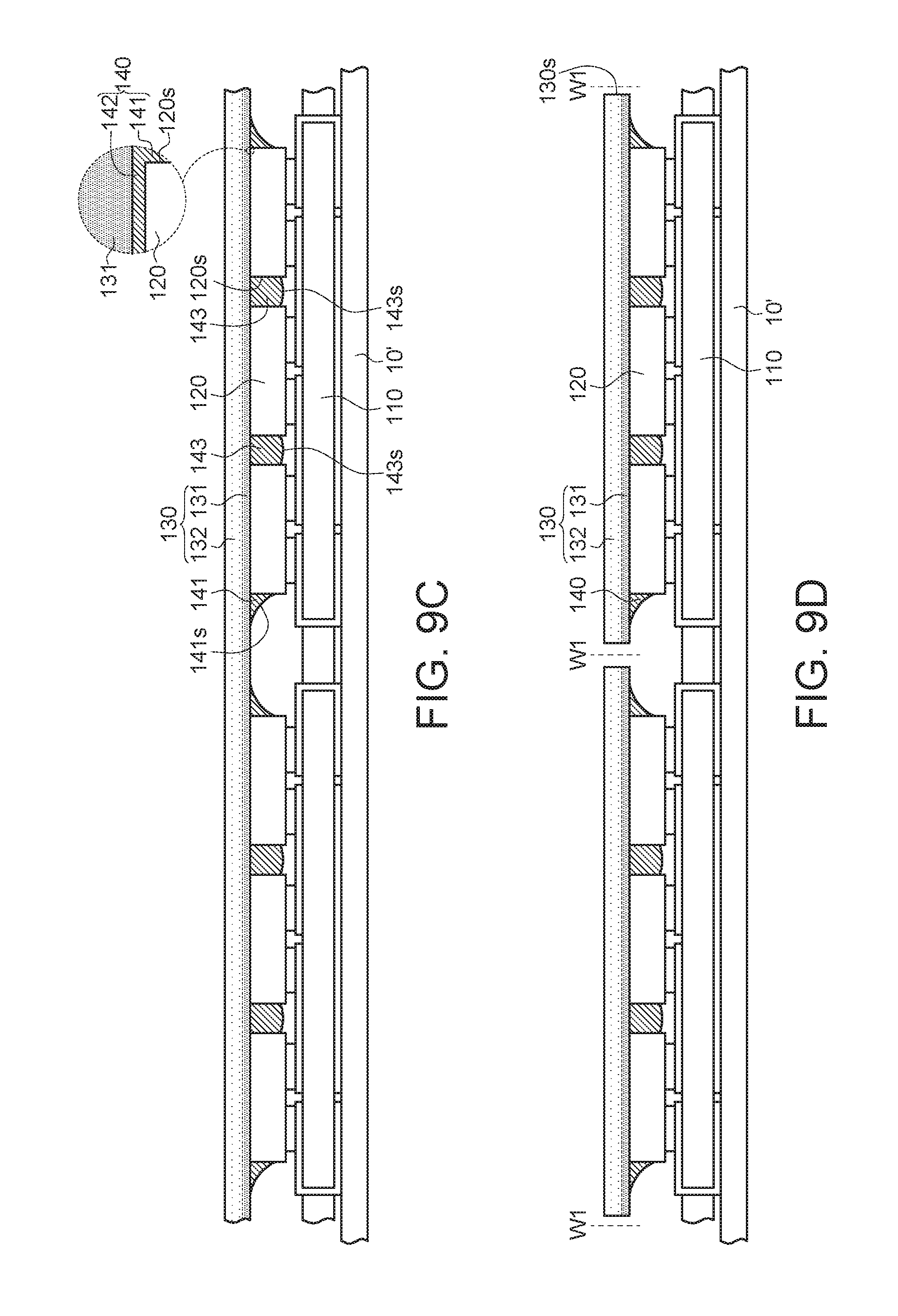
D00013

D00014
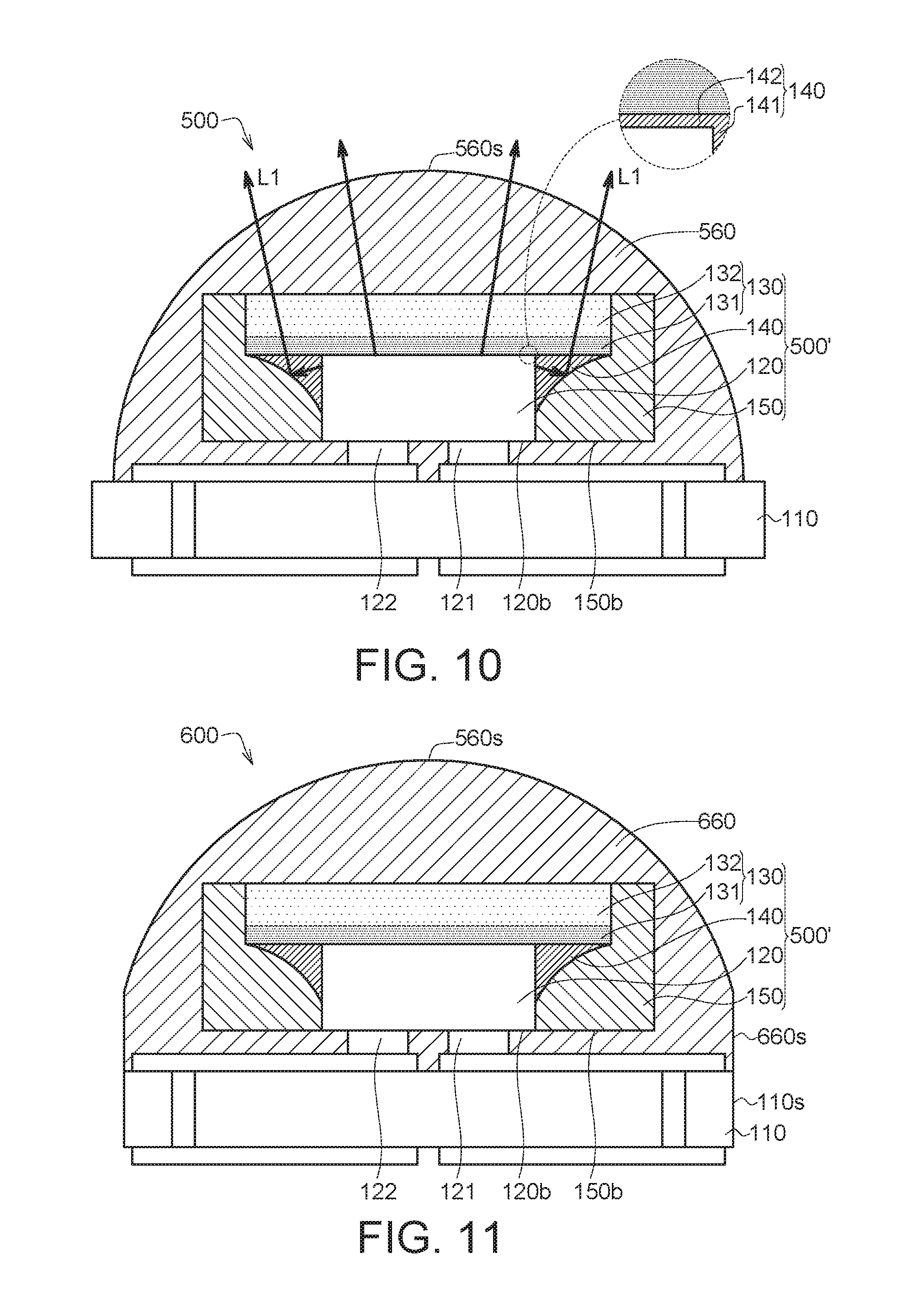
D00015
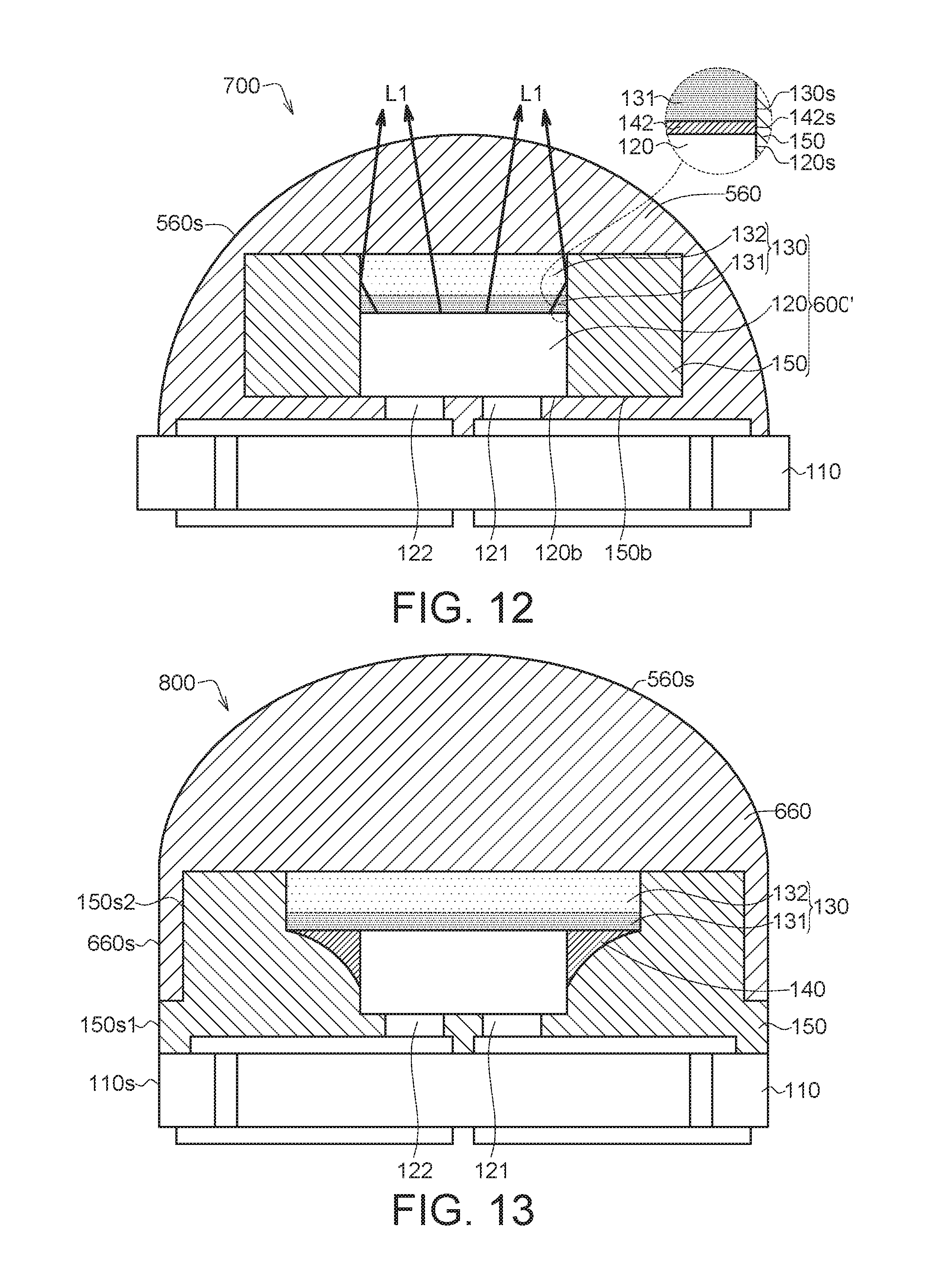
D00016
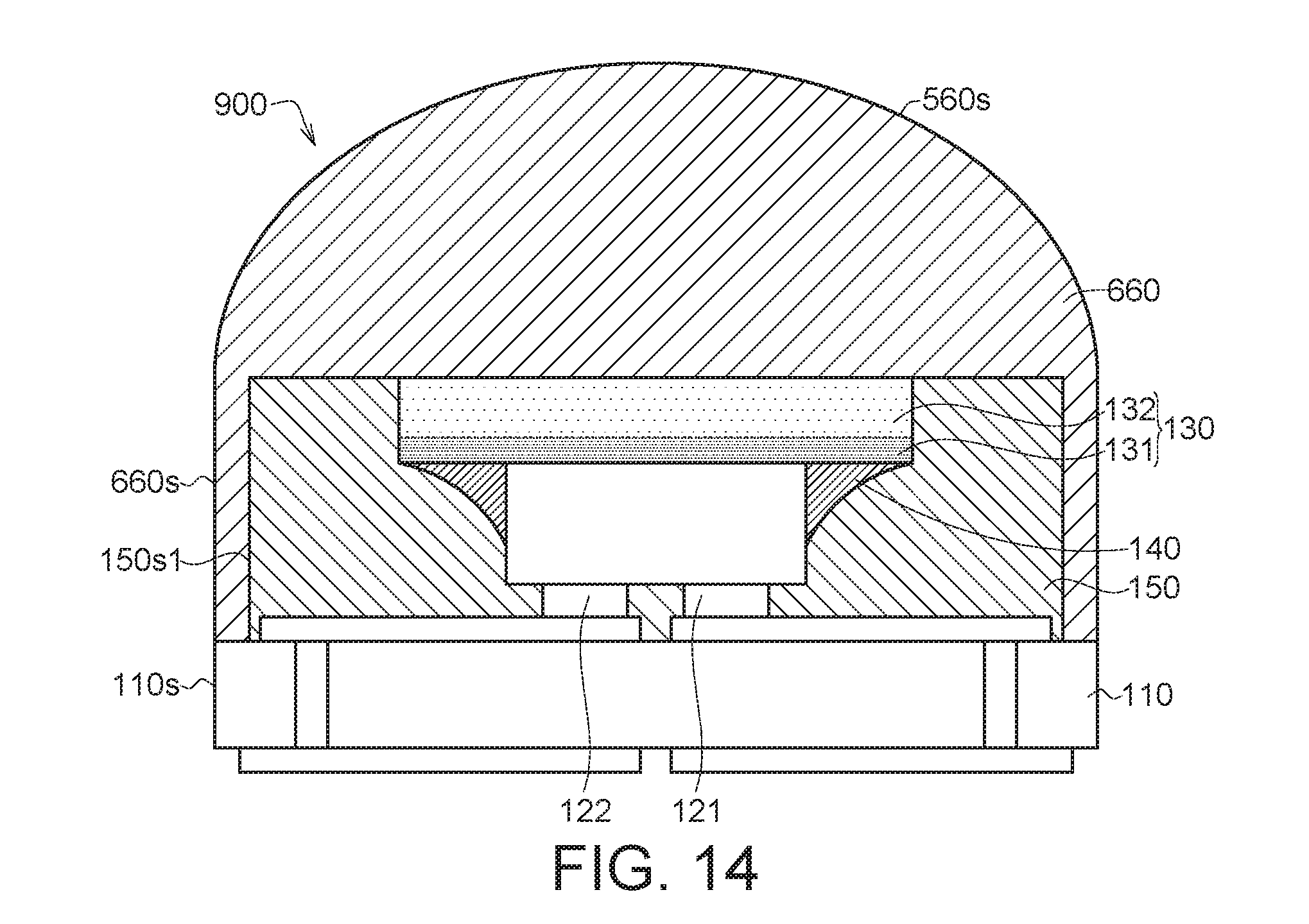
D00017
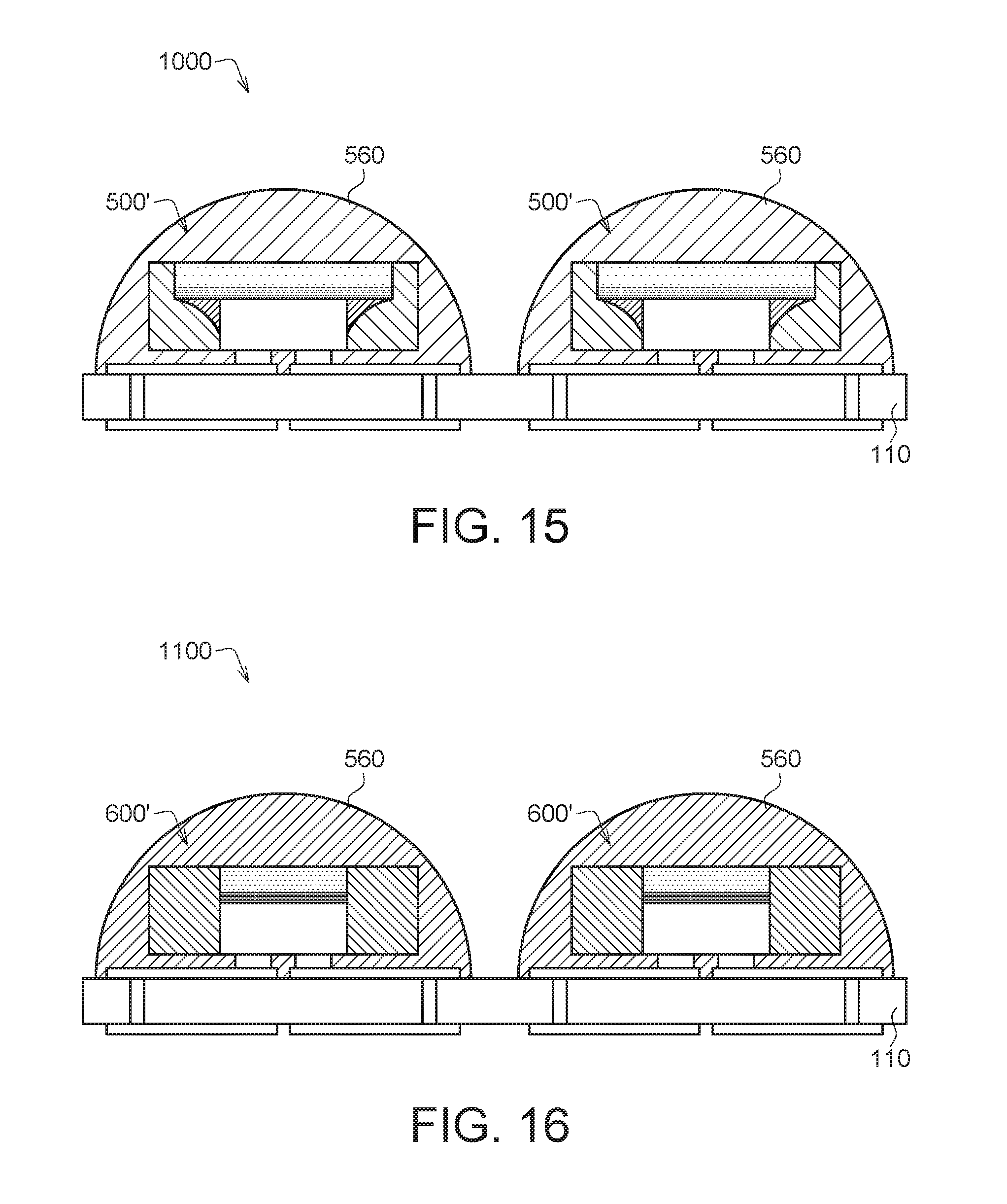
D00018

D00019
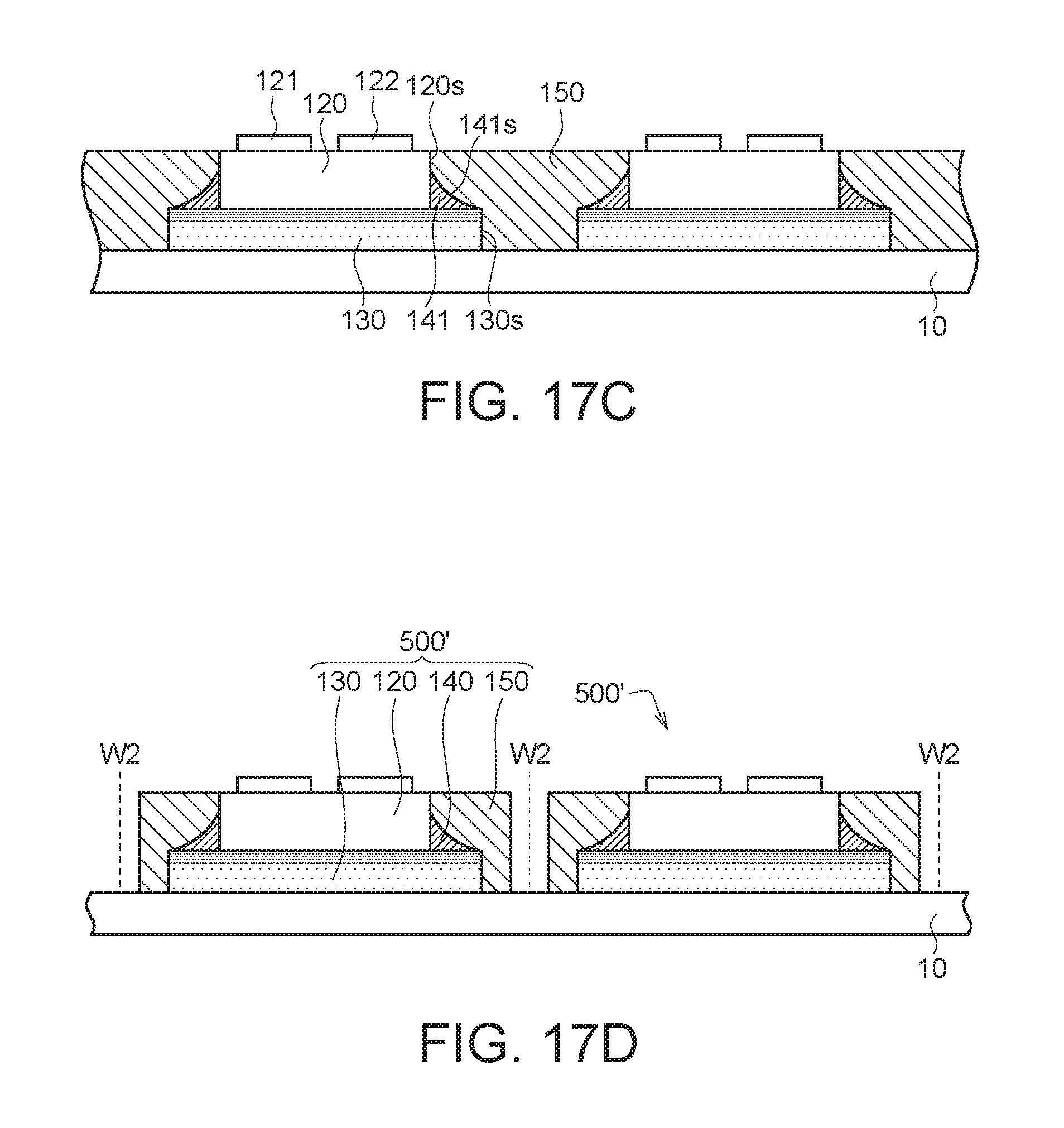
D00020

D00021

D00022
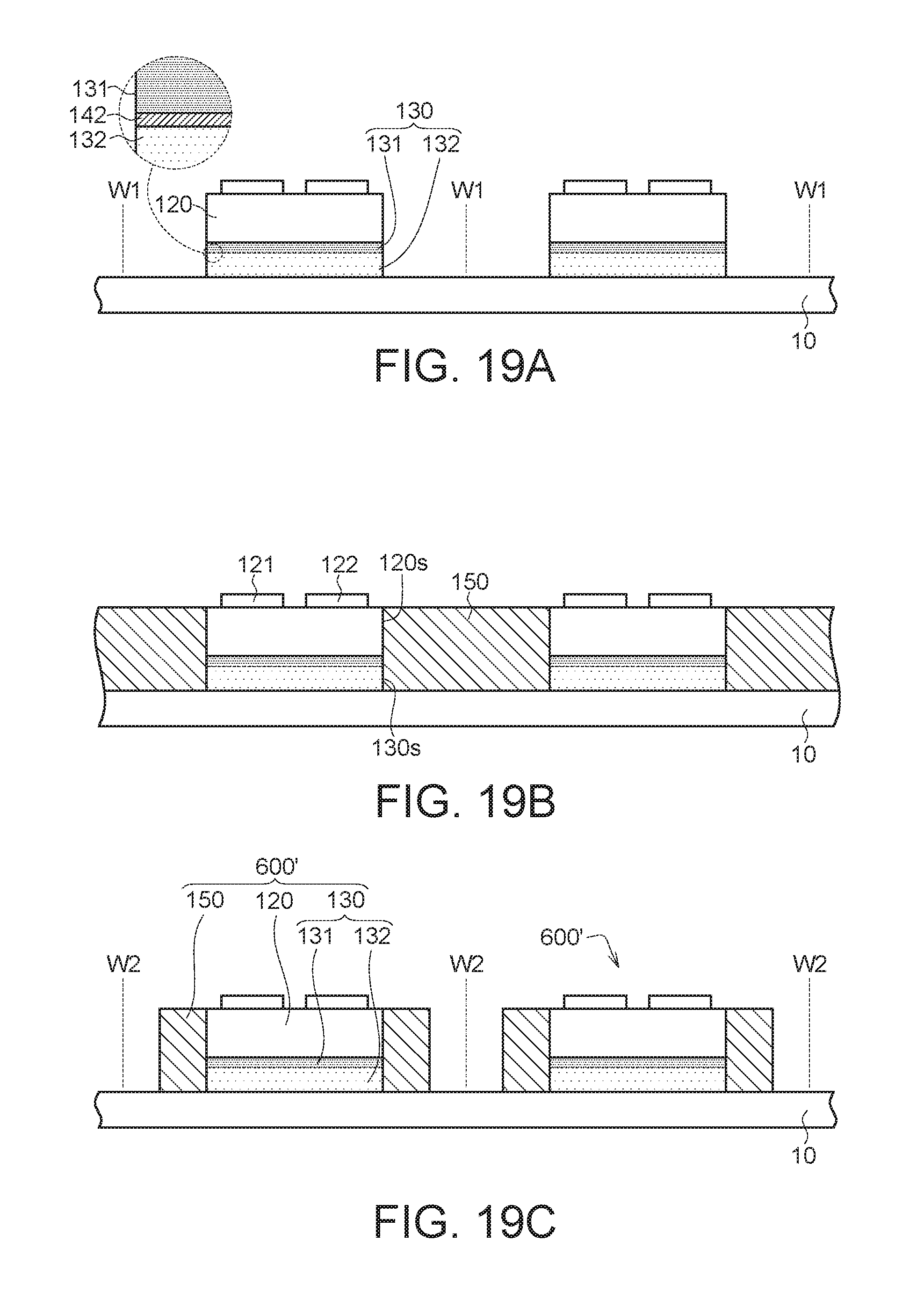
D00023
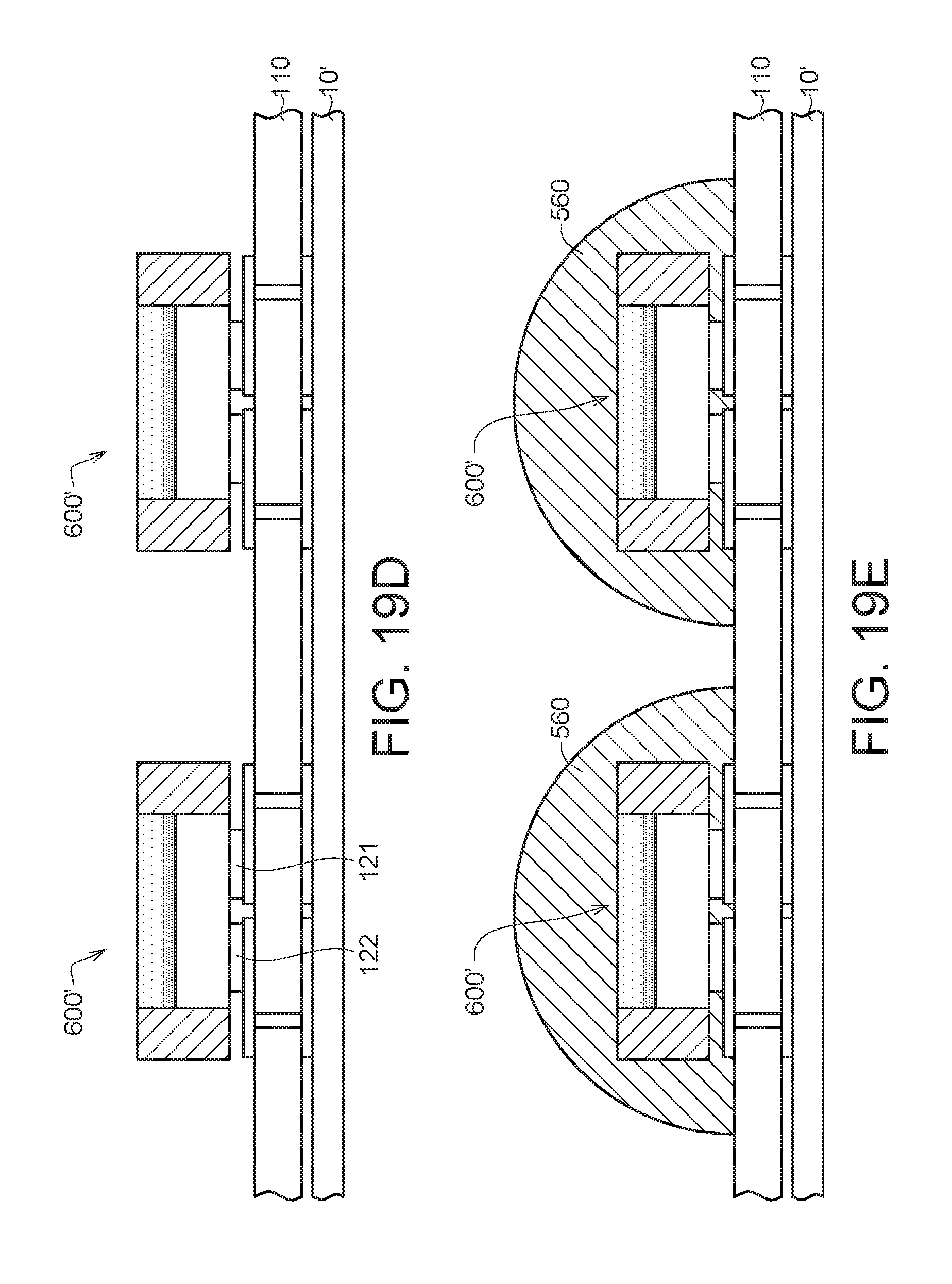
D00024
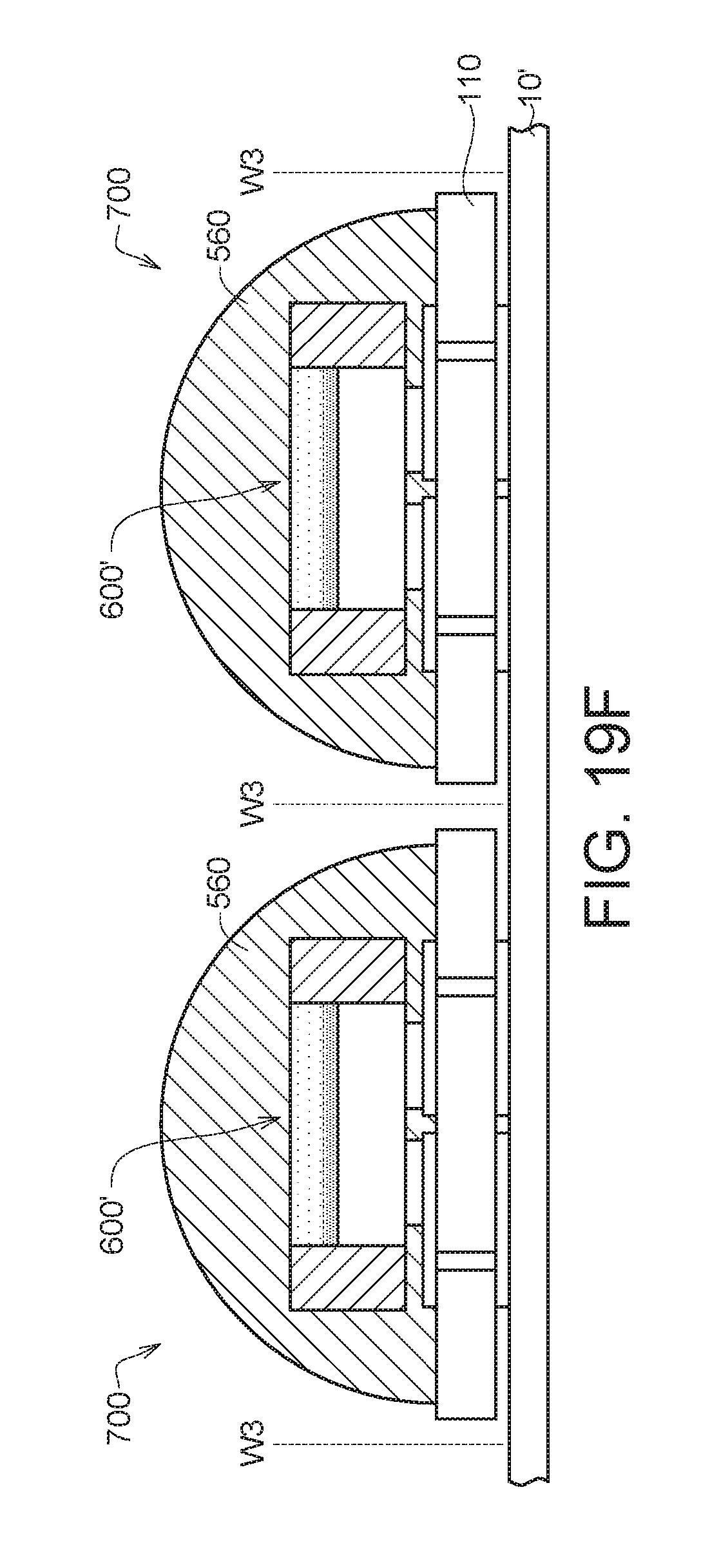
D00025
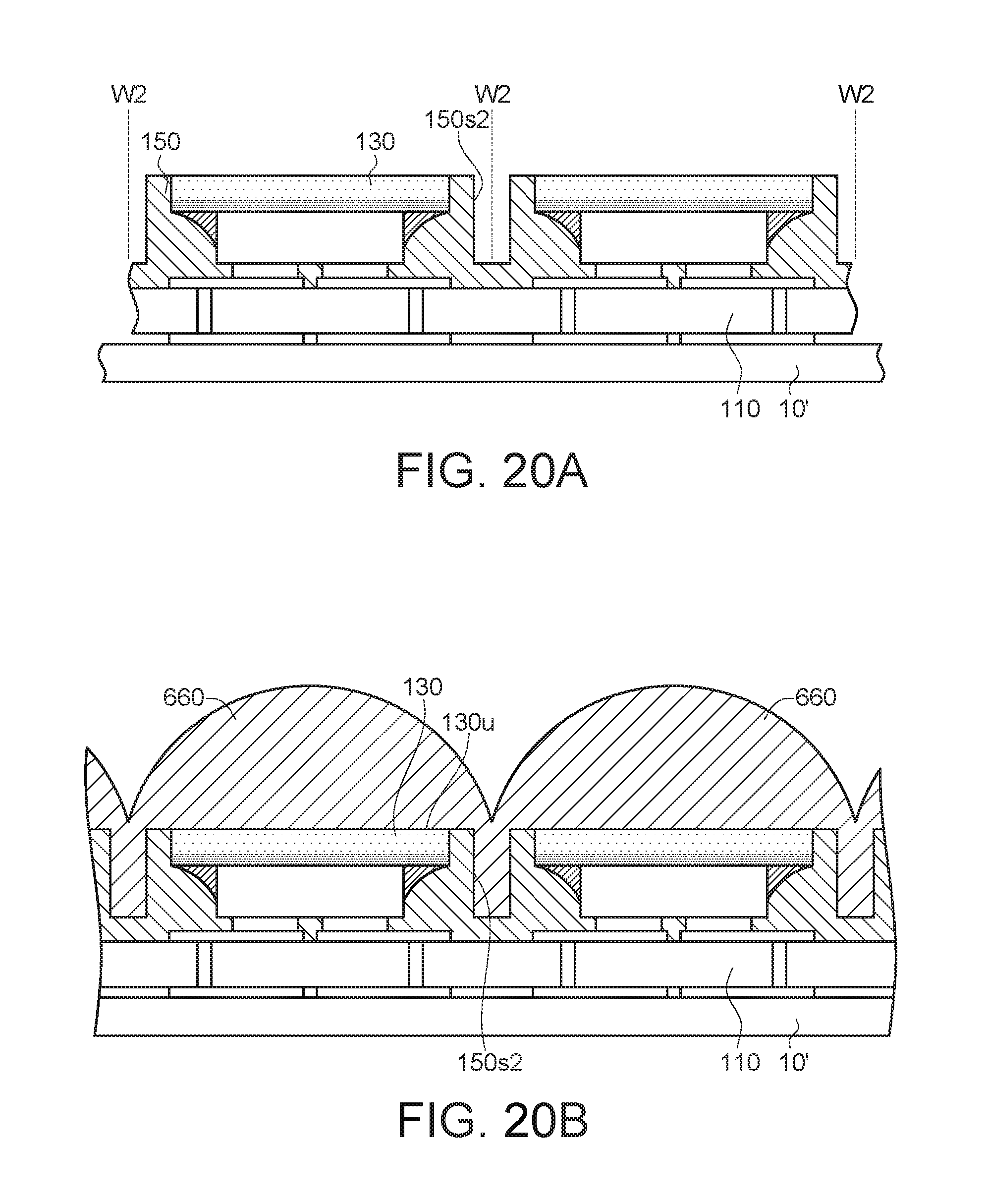
D00026

D00027
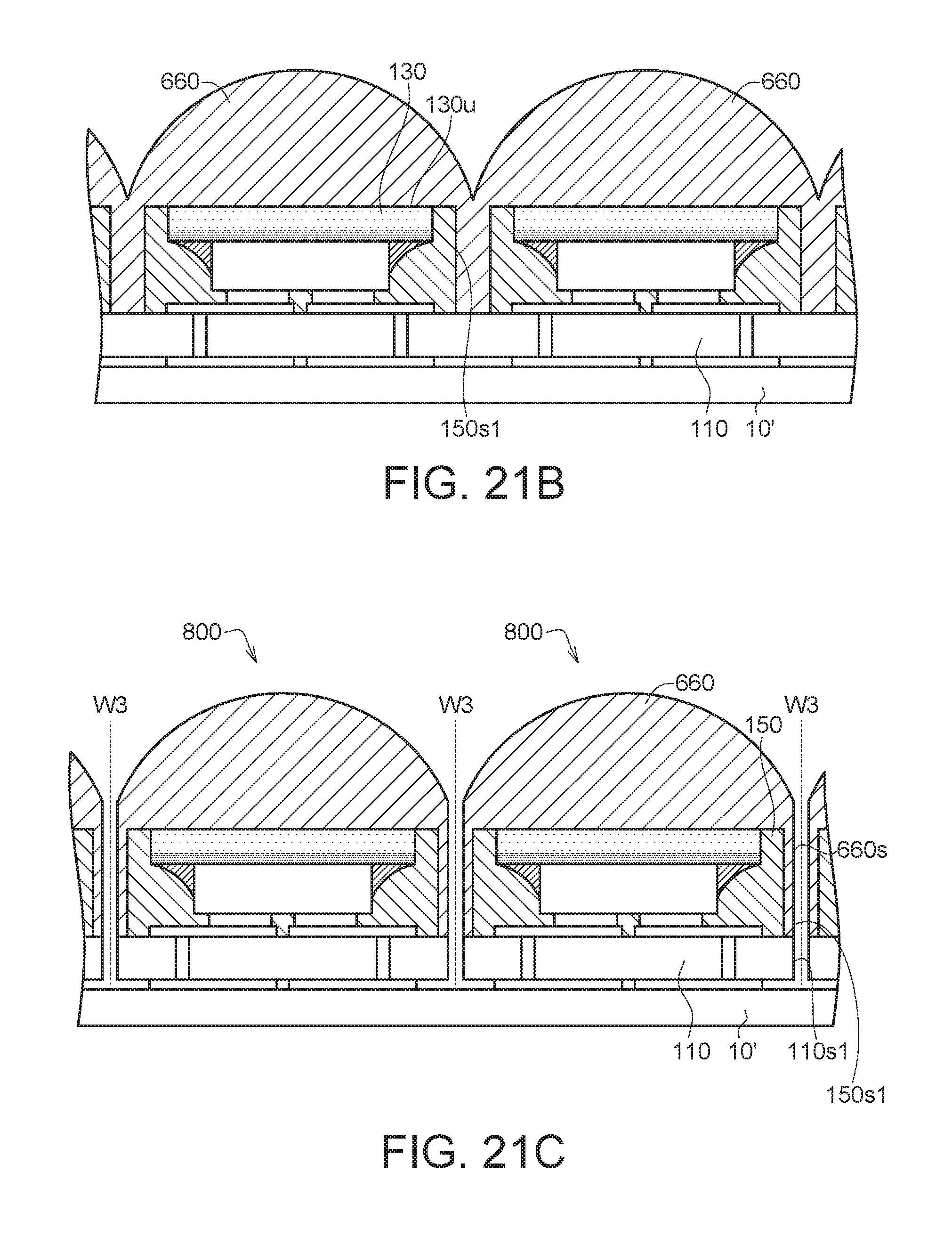
D00028

D00029

XML
uspto.report is an independent third-party trademark research tool that is not affiliated, endorsed, or sponsored by the United States Patent and Trademark Office (USPTO) or any other governmental organization. The information provided by uspto.report is based on publicly available data at the time of writing and is intended for informational purposes only.
While we strive to provide accurate and up-to-date information, we do not guarantee the accuracy, completeness, reliability, or suitability of the information displayed on this site. The use of this site is at your own risk. Any reliance you place on such information is therefore strictly at your own risk.
All official trademark data, including owner information, should be verified by visiting the official USPTO website at www.uspto.gov. This site is not intended to replace professional legal advice and should not be used as a substitute for consulting with a legal professional who is knowledgeable about trademark law.